

BOLETIN DE PESCA
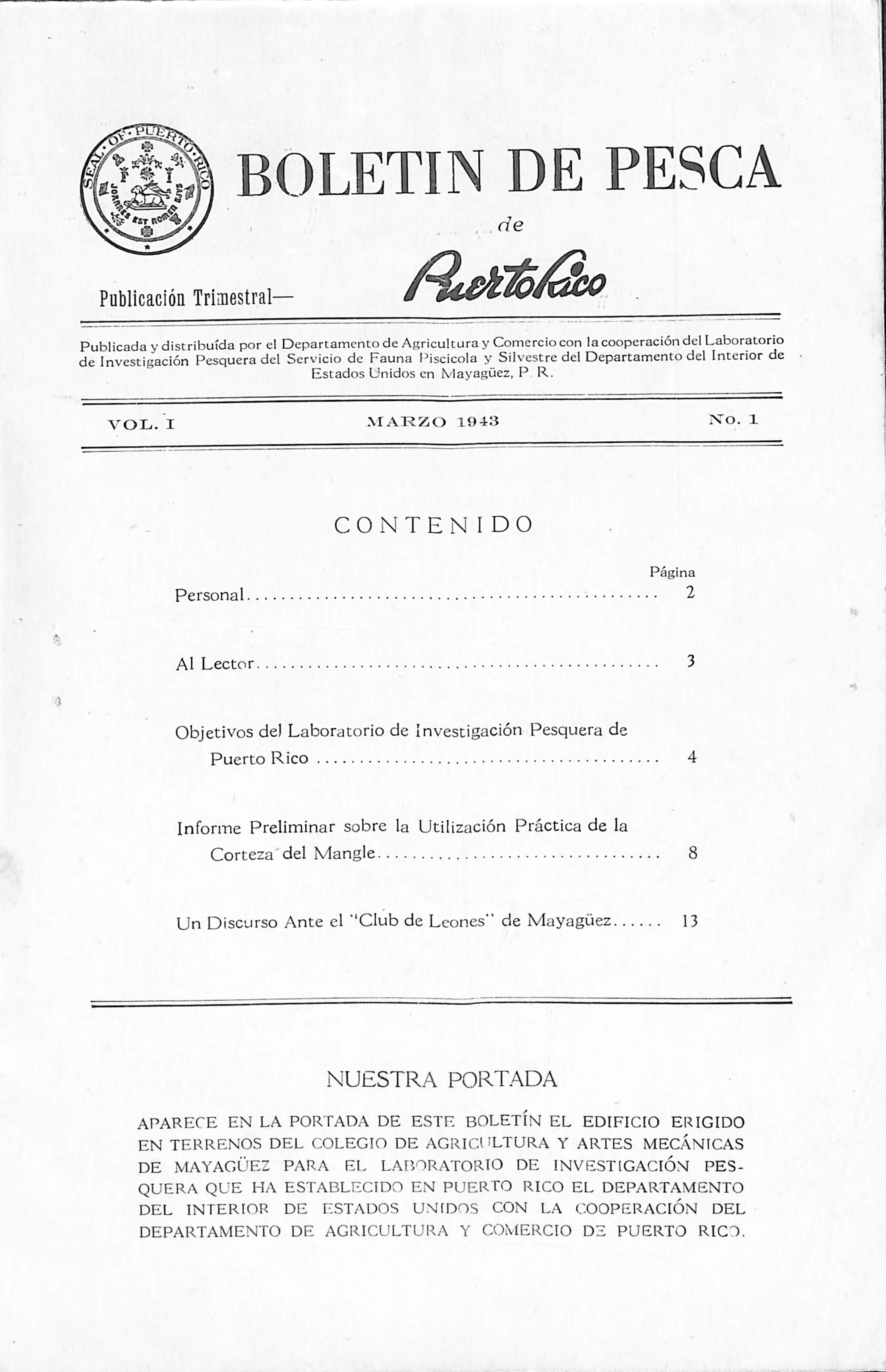
Publicación Trimestral—
Publicada y distribuida por el Departamento de ABricultura y Comercio con la cooperación del Laboratorio de Investigación Pesquera del Servicio de Fauna Piscicola y Silvestre del Departamento del Interior de Estados Unidos en Mayagüez, P R.
MARZO 1943 CONTENIDO
Personal. Al Lector 3
Objetivos del Laboratorio de Investigación Pesquera de Puerto Rico 4
Informe Preliminar sobre la Utilización Práctica de la Corteza del Mangle 8
Un Discurso Ante el ''Club de Leones" de Mayagüez 13
NUESTRA PORTADA
APARECE EN LA PORTADA DE ESTE BOLETÍN EL EDIFICIO ERIGIDO EN TERRENOS DEL COLEGIO DE AGRIO ILTURA Y ARTES MECÁNICAS DE MAYAGÜEZ PARA EL LABORATORIO DE INVESTIGACION PES QUERA QUE HA ESTABLECIDO EN PUERTO RICO EL DEPARTAMENTO DEL INTERIOR DE ESTADOS UNIDOS CON LA COOPERACIÓN DEL DEPARTAMENTO DE AGRICULTURA Y COMERCIO DE PUERTO RICO.

PERSONAL
Fernando A. Villaaiil, Comisionado de A-gvicultuva y Comercio.
Luis A. Izquierdo, Suhcomisionado de AgriculUira.
José García Abreu, Suhcomisionado de Comercio.
División de Ornitología y Piscicultura
Luis C. Bonnet, Jefe de la División.
Rafael Pérez Diez, Ornitólogo, José E. Polanco, Técnico Pesquero.
Ventura Barnés, Jr. Ingeniero Pesquero.
Pedro Vergne Roig, Economista Pesquero,
Luis R. Quiñones, Tecnólogo Pesquero.
Félix Iñigo, Superintendente, Vivero de Peces.
Boris o. Knake, Capitán, Emharcación W. B. Lewis.
Laboratorio de Investigación Pesquera de Mayagüez
J. F. PUNCOCHAR, Tecnólogo a Cargo.
Richard T. Whiteleather, Ingeniero Pesquero.
Glarbnce R. Lucas, Economista Pesquero.

AL LECTOR
Se inicia la publicación de este Boletín con el objeto de poner a disposición del público la información relativa a los experimentos, ensayos, pruebas y toda clase de trabajos que se realizan en Puerto Rico con la mira de fomentar la industria pesquera e investigar los problemas inherentes a la misma, los cuales son objeto de la asidua atención del personal del Laboratorio de Investigación Pesquera que funciona en Mayagüez, por cooperación del Servicio de Fauna Piscí cola y Silvestre del Departamento del Interior de Estados Unidos y de la División de Ornitología y Piscicultura del Departamento de Agricultura y Comercio de Puerto Rico.
La idea es mantener una publicación oficial en la cual aparezcan con la deseable periodicidad los conocimientos adquiridos a virtud de los estudios que están realizándose, así como el resultado de las gestiones que viene haciendo la Administración pai'a el fomento de la pesca comercial en la isla.
Este Boletín será enviado libre de costo a los pescadores de Puerto Rico, a los maestros de escuela, a las organizaciones y clubs cívicos, a los centros de investigación pesquera de Estados Unidos y de los países latinoamericanos, a las principales universidades y bibliotecas del He misferio y a todas aquellas personas particulares que lo soliciten.
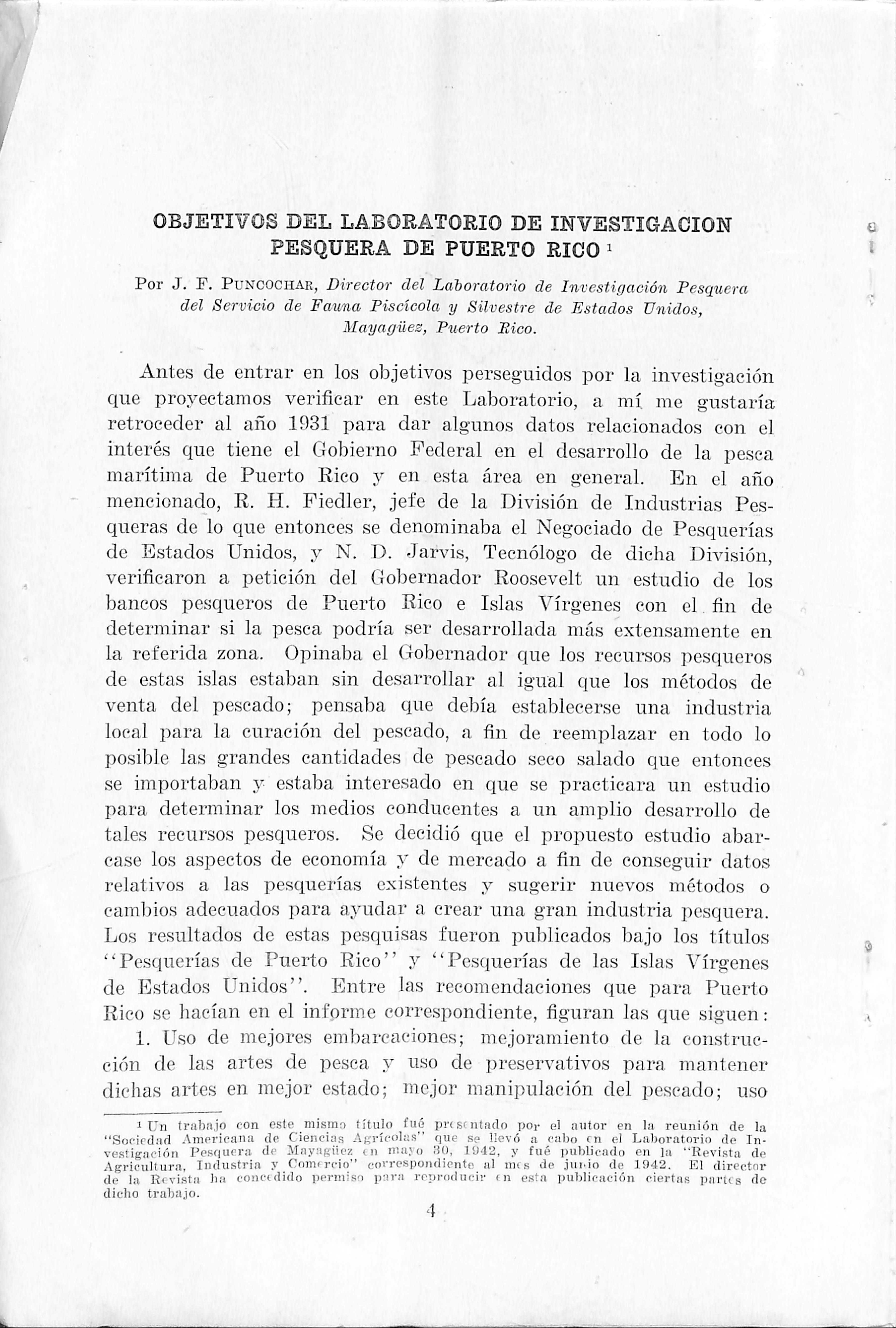
OBJETIVOS DEL LABORATORIO DE INVESTIGACION
PESQUERA DE PUERTO
RICO
^
Por J. F. PuNCOCHAR, Director del Laboratorio de Investigación Pesquera del Servicio de Fauna Piscícola y Silvestre de Estados Unidos, Mayagües, Puerto Eico.
Antes de entrar en los objetivos perseguidos por la investigación que proyectamos verificar en este Laboratorio, a mi me gustaría retroceder al año 1931 para dar algunos datos relacionados con el interés que tiene el Gobierno Federal en el desarrollo de la pesca marítima de Puerto Rico y en esta área en general. En el año mencionado, R. H. Fiedler, jefe de la División de Industrias Pes queras de lo que entonces se denominaba el Negociado de Pesquerías de Estados Unidos, y N. D. Jarvis, Tecnólogo de dicha División, verificaron a petición del Gobernador Roosevelt un estudio de los bancos pesqueros de Puerto Rico e Islas Vírgenes con el fin de determinar si la pesca podría ser desarrollada más extensamente en la referida zona. Opinaba el Gobernador que los recunsos pesqueros de estas islas estaban sin desarrollar al igual que los métodos de venta del pescado; pensaba que debía establecerse una industria local para la curación del pescado, a fin de reemplazar en todo lo posible las grandes cantidades de pescado seco salado que entonces se importaban y estaba interesado en que se practicara un estudio para determinar los medios conducentes a un amplio desarrollo de tales recursos pesqueros. Se decidió que el propuesto estudio abar case los aspectos de economía y de mercado a fin de conseguir datos relativos a las pesquerías existentes y sugerir nuevos métodos o cambios adecuados para ayudar a crear una gran industria pesquera. Los re.sultados de estas pesquisas fueron publicados bajo los títulos "Pe.squerías de Puerto Rico" y "Pesquerías de las Islas Vírgenes de Estados Unidos". Entre las recomendaciones que para Puerto Rico se hacían en el informe correspondiente, figuran las que siguen: 1. Uso de mejores embarcaciones; mejoramiento de la construc ción de las artes de pesca y uso de preservativos para mantener dichas artes en mejor estado; mejor manipulación del pescado; uso
1 Un tralla,jo con este niismo título fue pn.stntado por el autor en la reunión de la "Socirdad Americana de Ciencias Agrícolas" que se llevó a cabo en el Laboratorio de In vestigación Pesquera de Mnyagüez tn mayo JU), 1942, y fué publicado en la "Revista de Agricultura, Industria y Oom<rcio" correspondiente al mes de junio de 1942. El director de la Revista lia conctdido permiso para reproducir (n esta publicación ciertas partes de dicho trabajo.

de hielo y refrigeración; más sanidad en los mercados de pescado y entre los vendedores ambulantes; nn sistema organizado de compra y distribución de pescado y utilización del sobrante mediante la cura ción del mismo.
Que se sepa, poco se ha hecho desde que se realizó el mencionado estudio y desde que en el año 1934 un joven-llamado Luis C. Bonnet hizo su aparición en este campo de actividades. Por entonces el interés de Bonnet era principalmente hacer algo para desarrollar la pesca de agua dulce en la Isla. Percatado de que los varios ríos y arroyos de la Isla podían proveer un excelente alimento para las clases pobres del país, el mencionado joven, estimulado por el Sr. Menéndez Ramos, Decano del Colegio de Agricultura y Artes Mecá nicas de la Universidad de Puerto Rico, y por el Dr. Hildebrand, del Servicio de Fauna Piscícola y Silvestre de Estados Unidos, se consagró a poblar los ríos y arroyos de la Isla con ciertas especies de peces traídas de los Estados Unidos que podían adaptarse a las condiciones existentes en Puerto Rico. Para desarrollar este esplén dido programa se estableció en Maricao, uno de los viveros de peces más modernos de este hemisferio, ülás adelante en el año 1939 el Sr. Fiedler, Jefe de la División de Industrias Pesqueras del presente Servicio de Fauna Piscícola y Silvestre de Estados Unidos, fué des tacado para servir como asesor técnico de la Comisión Educativa del Presidente que se envió a Puerto Rico para estudiar las facili dades de la Universidad de Puerto Rico y determinar si esta insti tución podría convertirse en una universidad interamericana. Una de las recomendaciones hechas por esta Comisión consistió en esta blecer un laboratorio de inve.stigaeión pesquera en la Isla con el objeto de impulsar el desarrollo de la pesca, tanto en Puerto Rico como en otros países latinoamericanos. Para conseguir esto se sugirió una estrecha cooperación con la Universidad de Puerto Rico y con otras agencias insulares.
Como resultado de esta labor y de los esfuerzos desplegados por el Gobierno Federal y por el Gobierno Insular, se acrecentó el interés por la pesca y se consiguieron fondos para constimir y equipar un laboratorio de investigación pesquera, así como para iniciar un pro grama de investigación de los recursos pesqueros de las aguas de Puerto Rico e Islas Vírgenes en particular y de las Antillas en general.
Los objetivos del Laboratorio de Investigación Pesquera están contenidos en un convenio pactado entre el Semúcio de Fauna Piscí cola y Silvestre del Departamento del Interior de Estados Unidos y el Departamento de Agricultura y Comercio de Puerto Rico. La

naturaleza y extensión del jírograma fueron determinadas por el Servicio después de consultar con el Comisionado de Agricultura y Comercio y con la Junta Consultiva de Pesca de Puerto Rico, creada por la Legislatura Insular a virtud de la Ley Núm. 157 de mayo 13, 1941. El programa incluye:
1. Evaluación de la presente naturaleza, extensión y magnitud de la industria pesquera de Puerto Rico.
2. Estudio de la provisión y distribución de los peces comes tibles que se encuentran en las afueras de la costa de Puerto Rico y en las aguas adyacentes.
3. Técnica de la preservación del pescado y desarrollo de los productos pesqueros preservados, y
4. Determinación de los aspectos económicos envueltos en la captura, preservación y venta del pescado.
Gran parte de la información que cae bajo el primer apartado ha sido obtenida ya. Al presente nos hallamos dedicados al trabajo de exploración que nos permitirá obtener información relativa al empleo de artefactos de pesca que en la actualidad se están usando con éxito en los Estados Unidos. Estamos probando esos artefactos en la pesca de la clase de peces que se encuentran en Puerto Rico y en las aguas adyacentes. Se harán exploraciones en cuanto a las oportunidades de pesca cerca de la orilla, mar afuera y en el fondo. Se harán esfuerzos para determinar los métodos más eficientes para la producción máxima sin poner en peligro el futuro de la indu.stria. Los diversos tipos de especies que se atrapen serán identificados y se propenderá a obtener datos en cuanto a la distribución estacional y espacial de los mismos. Se cogerán ejemplares de peces para estudiar en techa iDosterior sus características de raza y especie y para estudiar también los fenómenos de la historia de su vida. Asimismo, se investigarán los factores que ejercen influencia sobre la abundancia y la distribución de los peces. El efecto de las con diciones corrientes sobre el movimiento de los peces, la distribución y la abundancia de los organismos que sirven de pasto a los mismos, observaciones en cuanto a la temperatura del agua y determinaciones del contenido de sal del agua serán considerados igualmente dentro de los trabajos de exploración que se han de verificar.
Las fases tecnológicas del programa abarcarán estudios en cuanto a la preservación del pescado a bordo de las embarcaciones pesqueras incluyendo los métodos más adecuados para helar, desangrar y limpiar el pescado. Otro extremo que se investigará será la preser vación adecuada de los productos pesqueros, en los puertos de desembarque. En relación con este punto, se estudiará el mejor tipo de envase que se utilizará para helar el pescado fresco para embarque. Se dará consideración a la posibilidad de usar neveras

de baja temperatura para depositar los productos pesqueros en los colmados. Se verificarán experimentos en relación con la prepara ción de pescado salado, especialinente mediante los métodos de sal seca y también en cuanto a la preparación de pescado ahumado. Con el pescado que se coja en las aguas de Puerto Rico se ensa yarán diversos métodos para el enlatado de productos pesqueros, incluyendo pescado fresco, ahumado y seco. Se dedicará algún tiempo, asimismo, a la preparación de derivados o productos secun darios. También se harán estudios relativos a la preservación química de hígados de pescado; la aeidulación del pescado y la utilización de residuos de moluscos para abonos, así como el secado de los residuos de pescado para usarlos como fuentes de minerales y proteínas para la dieta de los animales domésticos.
Los estudios económicos incluirán los que siguen: facilidades de transportación, por carreteras y ferrocarriles j facilidades paia la venta del pescado a través de tiendas para la venta al detall; salarios obtenidos por diversos grupos de la población y su capacidad para comprar pescado; hábitos del pueblo en lo que concierne a alimenta ción; localización de los puertos pesqueros en relación con los centros de población; posibilidad de cambiar tales puertos; y facilidades existentes en la actualidad para la preservación de los productos pesqueros.
De estas breves observaciones en cuanto a los objetivos del Labo ratorio de Investigación Pesquera puede apreciarse que la labor que nosotros tenemos por delante no es nada fácil. Resulta imposible predecir el tiempo que se necesitará para desarrollar nuestro pro grama. La guerra ha determinado inconvenientes que acaso afecten adversamente nuestra gestión. En el corto período de tiempo que hemos estado en Puerto Rico, algunos de nuestros esfuerzos han comenzado a dar fruto ya. Hemos podido notar que sugerencias hechas por nosotros están siendo acogidas por firmas que última mente se han dedicado a la industria pesquera y que han puesto en práctica nuestras recomendaciones en cuanto a la manipulación y refrigeración del pescado a bordo de las embarcaciones, en los puntos de desembarque y durante el viaje hacia el mercado.
Con la cooperación de otras agencias federales e insulares estamos ayudando a establecer cooperativas de pescadores en varios puntos de la Isla. A dichas cooperativas se han hecho préstamos para la compra de embarcaciones y artefactos de pesca, así como para el mejoramiento de las facilidades con que se cuenta en los puertos. También están estudiándose planes para proporcionarles terreno a los pescadores, con el fin de mejorar las condiciones de vida en los centros pesqueros.
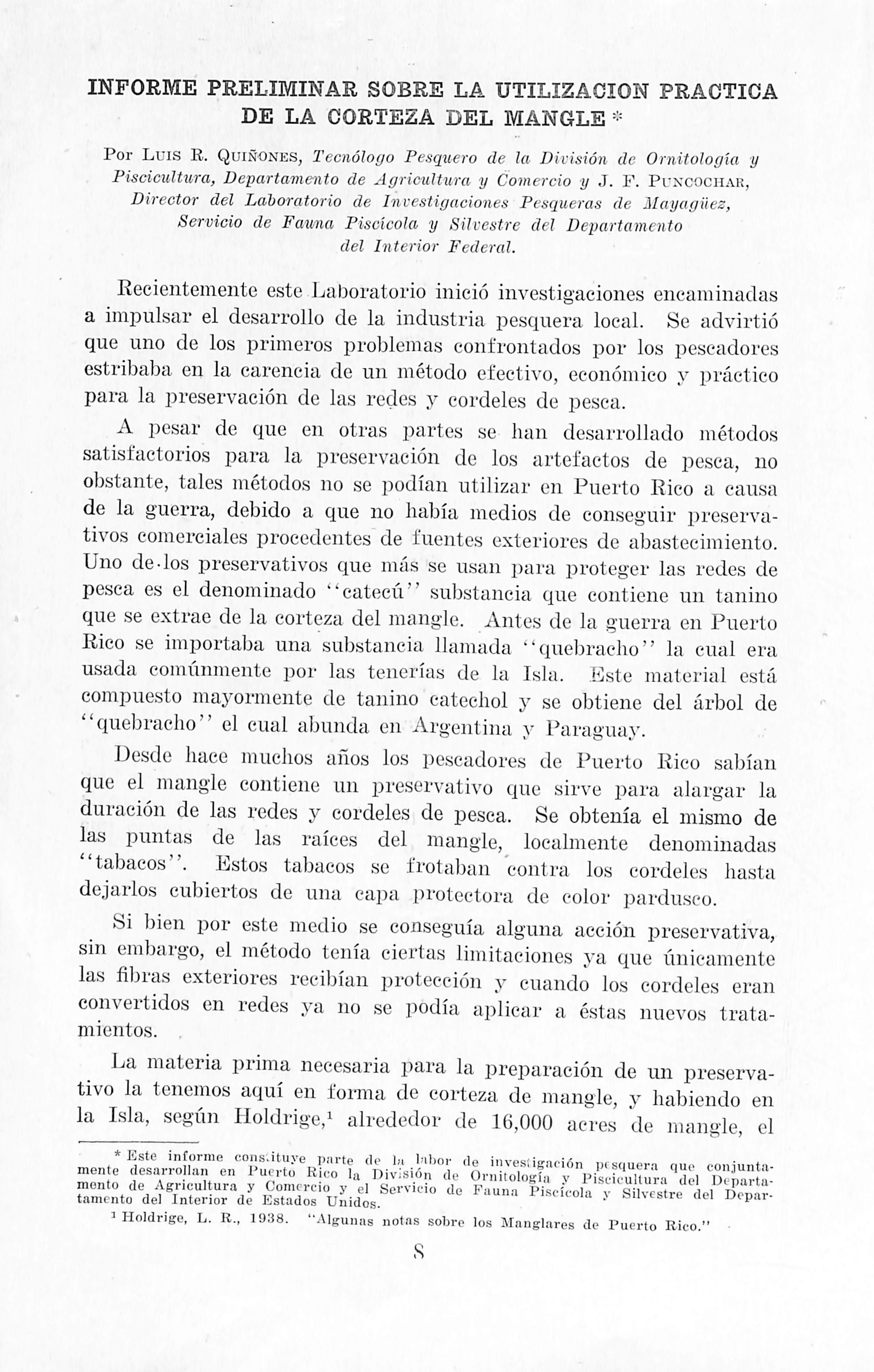
DE LA CORTEZA DEL MANGLE -
Por Luis E. Quiñones, Tecnólotjo Pesqiiero de la División de Ornilología y Piscicultura, Departamento de Agricultura y Comercio y J. F. Puncochar, Director del Laboratorio de Investigaciones Pesqueras de Mayagiiez, Servicio de Fauna Piscícola y Silvestre del Departamento del Interior Federal.
Recientemente este Jjaboratorio inició investigaciones encaminadas a impulsar el desarrollo de la industria i^esquera local. Se advirtió que uno de los primeros problemas confrontados por los pescadores estribaba en la carencia de un método efectivo, económico y práctico para la preservación de las redes y cordeles de pesca.
A pesar de que en otras partes se han desarrollado métodos satisfactorios para la preservación de los artefactos de pesca, no obstante, tales métodos no se podían utilizar en Puerto Rico a causa de la guerra, debido a que no había medios de conseguir preserva tivos comerciales procedentes de fuentes exteriores de abastecimiento. Uno dedos preservativos que más se usan para proteger las redes de pesca es el denominado "eatecú" substancia que contiene un tanino que se extrae de la corteza del mangle. Antes de la guerra en Puerto Rico se importaba una substancia llamada "quebracho" la cual era usada comúnmente jDor las tenerías de la Isla. Usté material está compuesto mayormente de tanino catechol y se obtiene del árbol de "quebracho" el cual abunda en Argentina y Paraguay.
Desde hace muchos años los pescadores de Puerto Rico sabían que el mangle contiene un preservativo que sirve para alargar la duración de las redes y cordeles de pesca. Se obtenía el mismo de las puntas de las raíces del mangle, localmente denominadas 'tabacos". Estos tabacos se frotaban contra los cordeles hasta dejarlos cubiertos de una capa protectora de color pardu.sco.
Si bien por este medio se conseguía alguna acción preservativa, sin embargo, el método tenía ciertas limitaciones ya que únicamente las fibras exteriores recibían protección y cuando los cordeles eran convertidos en redes ya no se podía aplicar a éstas nuevos trata mientos.
La materia prima necesaria para la preparación de un preserva tivo la tenemos aquí en foi-ma de corteza de mangle, y habiendo en la Isla, según Holdrige,i alrededor de 16,000 acres de mangle, el
man.: " "r. manto de Agncultur.-, y Comercio y el Servicio de Fauno Pi'.s(úY-ola''v''silv/sUe lamento del Interior de Estados Unidos. ciintsire aei uepar mioldrige, L. R., 1938. "Alguims notas sobro los Manglares de Puerto Rico."
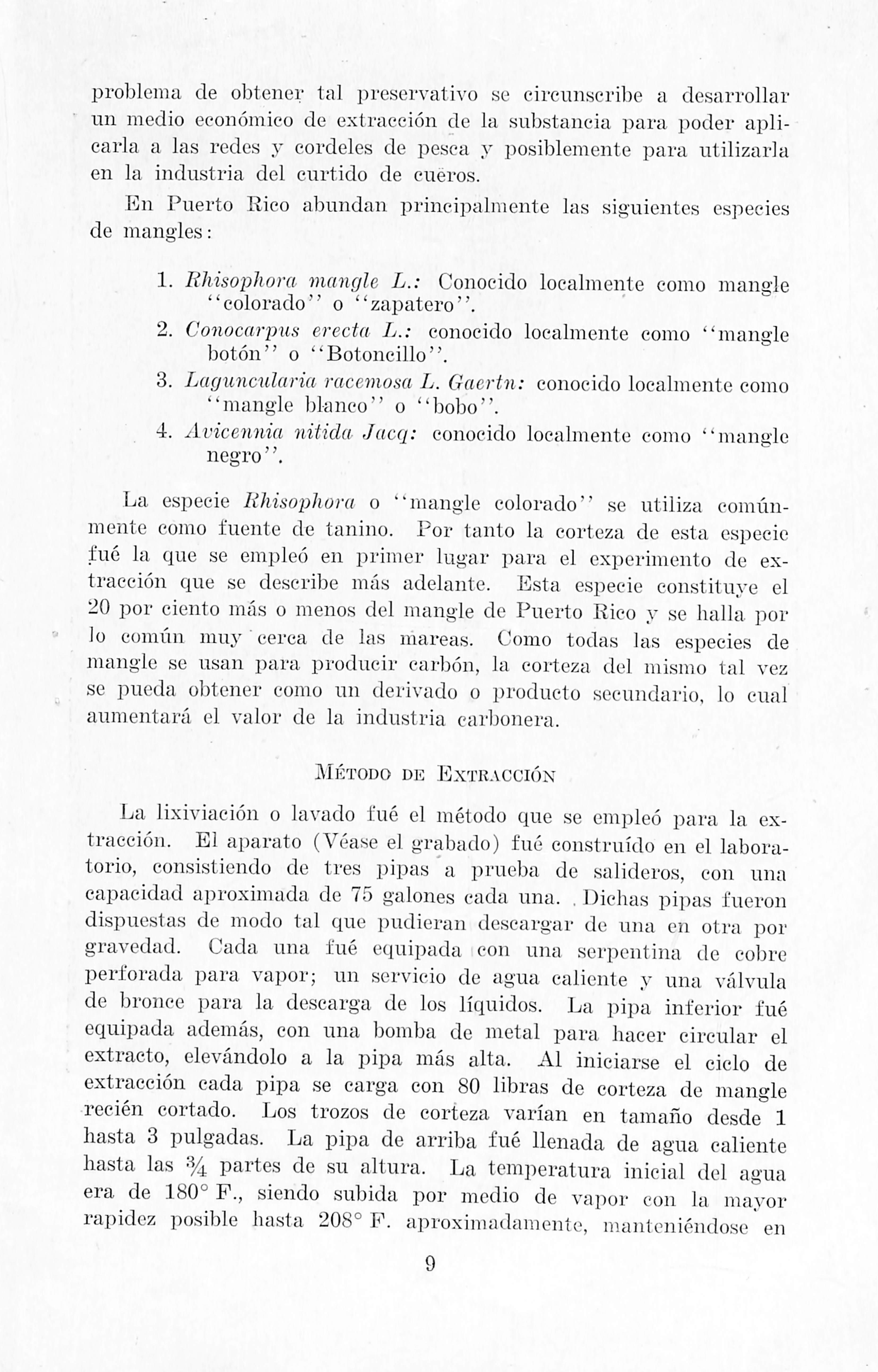
problema de obtener tal preservativo se circunscribe a desarrollar un medio económico de extracción de la substancia para poder apli carla a las redes y cordeles de pesca y posiblemente para utilizarla en la industria del curtido de cueros.
En Puerto Rico abundan principalmente las siguientes especies de mangles:
1. Rliisopliova mangle L.: Conocido loealmente como mangle "colorado" o "zapatero".
2. Conocarpus erecta L.; conocido loealmente como "mangle botón" o "Botoncillo".
3. Lagunciilaria racemosa L. Gaertn: conocido loealmente como "mangle blanco" o "bobo".
4. Avicennia niticla Jucq; conocido loealmente como "mangle negro".
La especie liJúsophora o "mangle colorado" se utiliza común mente como fuente de tanino. Por tanto la corteza de esta especie fué la que se empleó en primer lugar para el experimento de ex tracción que se describe más adelante. Esta especie constituye el 20 por ciento más o menos del mangle de Puerto Rico y se halla, pol lo común muy cerca de las mareas. Como todas las especies de mangle se usan para producir carbón, la corteza del mismo tal vez se pueda obtener como un derivado o producto secundario, lo cual aumentará el valor de la industria carbonera.
Método de Extr.icción
La lixiviación o lavado fué el método que se empleó para la ex tracción. El aparato (Véase el grabado) fué construido en el labora torio, consistiendo de tres pipas a prueba de salideros, con una cajiacidad ajiroximada de 75 galones cada una. . Dichas pipas fueron dispuestas de modo tal que pudieran descargar de una en otra por gravedad. Cada una fué equipada con una serpentina de cobre jieifoiada para vajiorj un servicio ele agua caliente y una válvula de bronce para la descarga de los líquidos. La pipa inferior fué equipada además, con una bomba de metal para hacer circular el extracto, elevándolo a la pipa más alta. Al iniciarse el ciclo de extracción cada pipa se carga con 80 libras de corteza de mangle recién cortado. Los trozos de corteza varían en tamaño desde 1 hasta 3 pulgadas. La pipa de arriba fué llenada de agua caliente hasta las % partes de su altura. La temperatura inicial del agua era de 180 F., siendo subida por medio de vapor con la mayor rapidez posible hasta 208 P. aproximadamente, manteniéndose en

GRABADO 1.—Aparato usado para' la extracción del tanino del mangle, las pipas se les ponen las tapas durante el proceso de la extracción. Las pipas que se ven en primer término se usan para depositar el extracto obtenido.
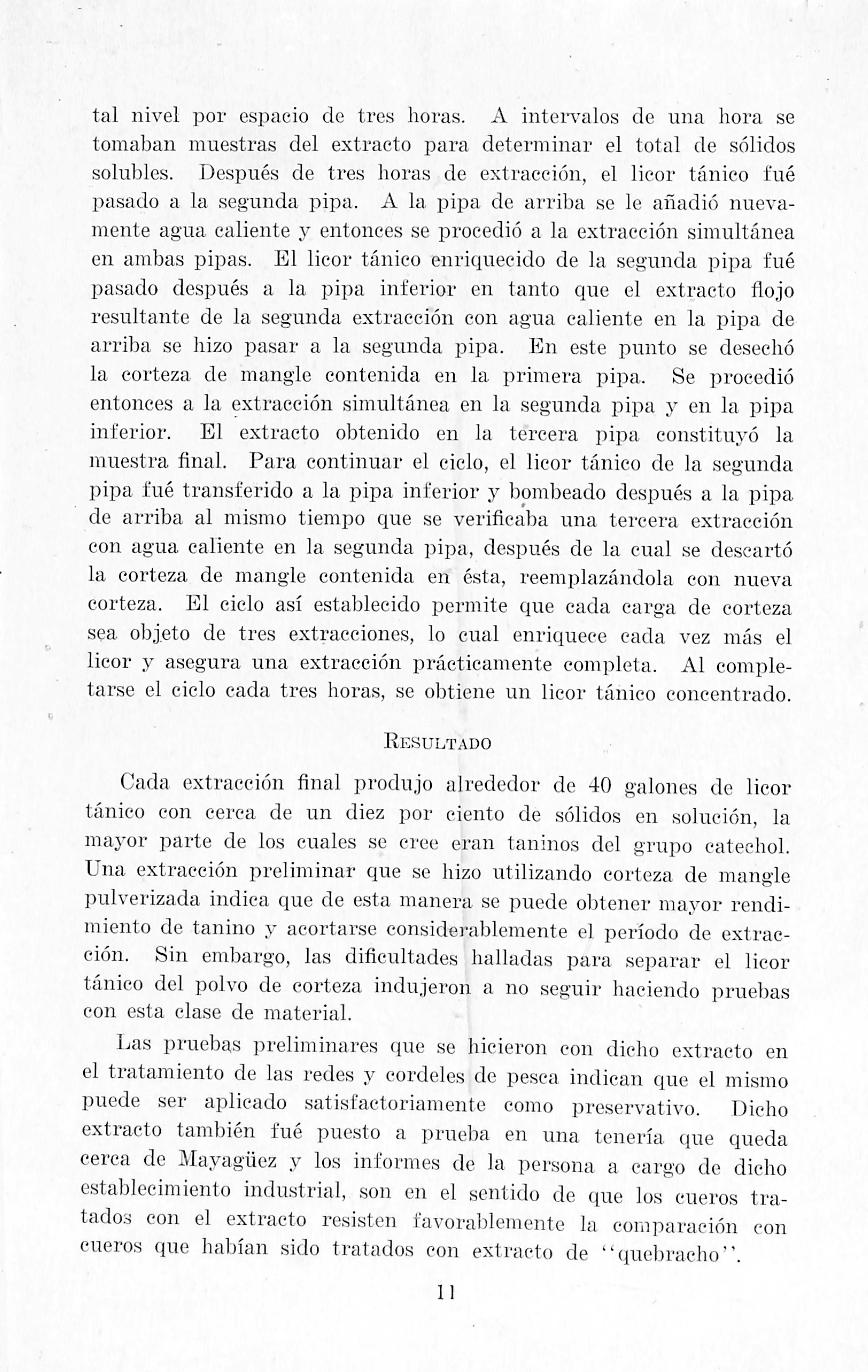
tal nivel por espacio de tres horas. A inténsalos de una hora se tomaban muesti'as del extracto para determinar el total de sólidos solubles. Después de tres horas de extracción, el licor tánico fué pasado a la .seg'unda pipa. A la pipa de arriba se le añadió nueva mente agua caliente y entonces se procedió a la extracción simultánea en ambas pipas. El licor tánico enriquecido de la segunda pipa fué pasado después a la pipa inferior en tanto que el extracto flojo resultante de la segunda extracción con agua caliente en la pipa de arriba se hizo pasar a la segunda pipa. En este punto se desechó la corteza de mangle contenida en la primera pipa. Se procedió entonces a la extracción simultánea en la segunda pipa y en la pipa inferior. El extracto obtenido en la tercera pipa constituyó la muestra final. Para continuar el ciclo, el licor tánico de la segunda pipa fué transferido a la pipa inferior y bombeado después a la pipa de arriba al mismo tiempo que se verificaba una tercera extracción con agua caliente en la segunda pipa, después de la cual se descartó la corteza de mangle contenida en ésta, reemplazándola con nueva corteza. El ciclo así establecido permite que cada carga de corteza sea objeto de tres extracciones, lo cual enriquece cada vez más el licor y asegura una extracción prácticamente completa. Al comple tarse el ciclo cada tres horas, se obtiene un licor tánico concentrado.
Resultado
Cada extracción final produjo alrededor de 40 galones de licor tánico con cerca de un diez por ciento de sólidos en solución, la mayor parte de los cuales se cree eran taninos del grupo catecbol. Una extracción preliminar que se hizo utilizando corteza de mangle pulverizada indica que de esta manera se puede obtener mayor rendi miento de tanino y acortarse considerablemente el período de extrac ción. Sin embargo, las dificultades halladas para separar el licor tánico del polvo de corteza indujeron a no .seguir haciendo pruebas con esta clase de material.
Las pruebas preliminares que se hicieron con dicho extracto en el tratamiento de las redes y cordeles de pesca indican que el mismo puede ser aplicado satisfactoriamente como preservativo. Dicho extracto también fué puesto a prueba en una tenería que queda cerca de Mayagüez y los informes de la persona a cargo de dicho establecimiento industrial, son en el sentido de que los cueros tra tados con el extracto resisten favorablemente la comparación con cueros que habían sido tratados con extracto de "quebracho".
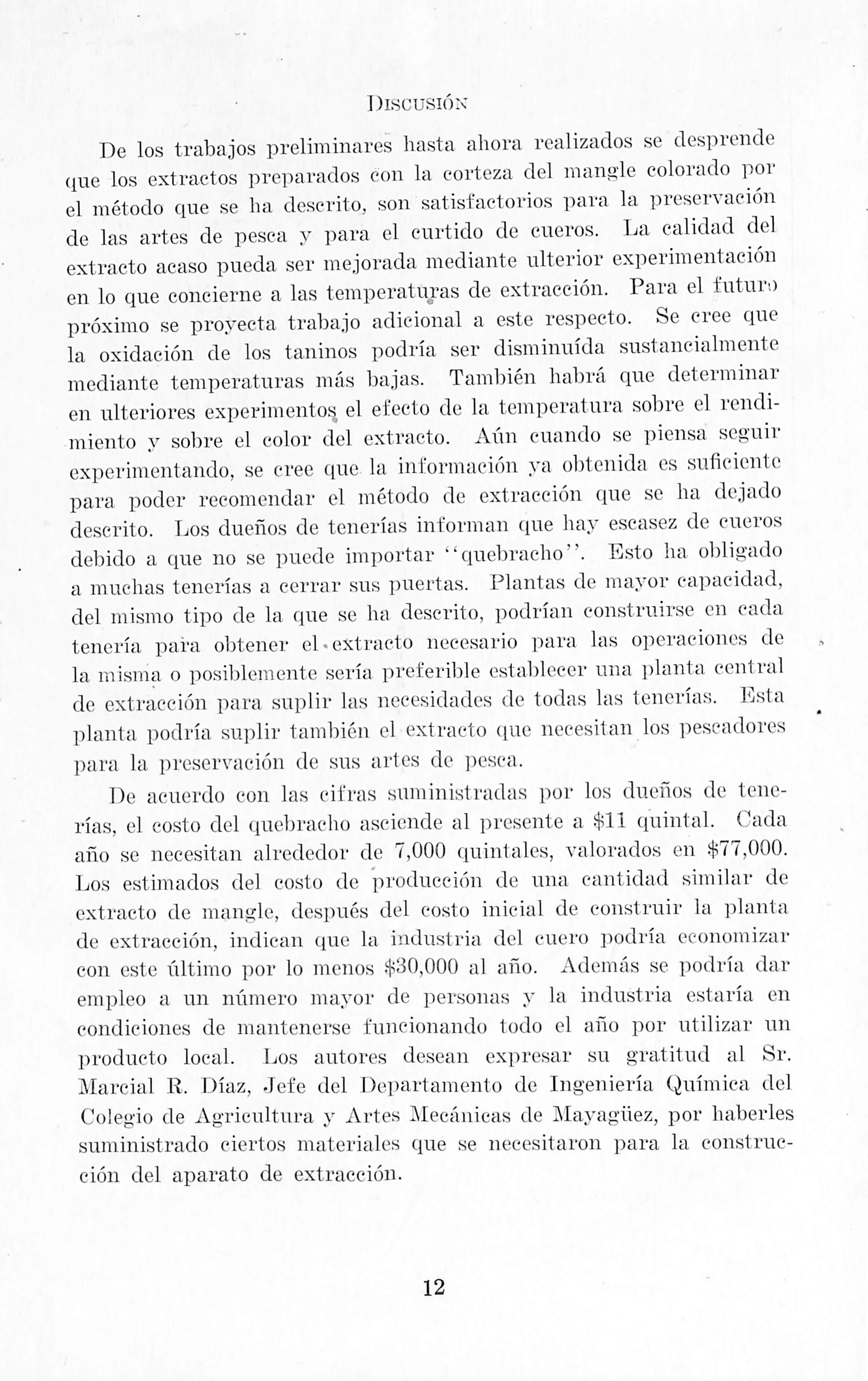
De los trabajos preliminares hasta ahora realizados se desprende que los extractos preparados con la corteza del mangle colorado pm' el método que se ha descrito, son satisfactorios para la preservación de las artes de pesca y para el curtido de cueros. La calidad del extracto acaso pueda ser mejorada mediante ulterior experimentación en lo que concierne a las temperaturas de extracción. Para el futuro próximo se proyecta trabajo adicional a este respecto. Se cree que la oxidación de los taninos podría ser disminuida sustancialmente mediante temperaturas más bajas. Tamliién habrá que determinai en ulteriores experimentoí^ el efecto de la temperatura sobre el rendi miento y sobre el color del extracto. Aún cuando se piensa seguii experimentando, se cree que la intormaeión ya obtenida es suíieionto para poder recomendar el método de extracción que se ha dejado descrito. Los dueños de tenerías informan que hay escasez de cueros debido a que no se puede importar "quebracho". Esto ha obligado a muchas tenerías a cerrar sus iiuertas. Plantas de mayor capacidad, del mismo tipo de la que se ha descrito, podrían construirse en cada tenería para obtener el-extracto necesario para las operaciones de la misma o posiblemente sería preferible establecer una planta central de extracción para suplir las necesidades de todas las tenerías. Esta planta podría suplir también el extracto (lue necesitan los pescadores para la preservación de sus artes de pesca.
De acuerdo con las cifras suministradas por los dueños de tene rías, el costo del quebracho asciende al presente a $11 quintal. Cada año se necesitan alrededor de 7,000 quintales, valorados en $77,000. Los estimados del costo de producción de una cantidad similar de extracto de mangle, de.spués del costo inicial de construir la planta de extracción, indican que la industria del cuero podría economizar con este último por lo menos $30,000 al año. Además se podría dar empleo a un número mayor de personas y la industria estaría en condiciones de mantenerse funcionando todo el año por utilizar un producto local. Los autores desean expresar su gratitud al Sr. Marcial R. Díaz, Jefe del Departamento de Ingeniería Química del Colegio de Agricultura y Artes Mecánicas de J\Iayagüez, por haberles suministrado ciertos materiales que se necesitaron para la construc ción del aparato de extracción.

UN DISCURSO *
Por Luis C. Bonnkt, Jefe Je la División de Ornitología y Piscicultura del Departamento de Agricultura y Comercio.
León Presidente, Compañeros Leones de la Selva de Mayagüez, Distinguidos Radioyentes:
La crisis actual ha creado muchos problemas en Puerto Rico y quizás el más importante de ellos es el que implica la necesidad de proveer suficientes alimentos para cubrir las necesidades de la densa población de la Isla. Debido al hecho de que Puerto Rico siempre ha dependido del exterior jiara su abastecimiento, nos encontramos con que la Isla no produce alimentos suficientes para su subsistencia. Tanto el Gobierno Insular como el Gobierno Federal están haciendo todo lo posible por encontrar medios para que Puerto Rico pueda bastarse a sí mismo en toda la extensión posible. Se está desarro llando un plan intenso y sistemático que tiende a fomentar la diver sificación de los productos agrícolas locales y el resultado de este plan, hasta la fecha, ha sido satisfactorio.
Considerando que las cosechas agrícolas no bastan para suplir todas las necesidades de alimentos de los habitantes de Puerto Rico, el Departamento de Agricultura y Comercio, a través de su División de Ornitología y Piscicultura y con la cooperación del Servicio de Fauna Piscícola y Silvestre del Deparlamento del Interior Federal, está llevando a cabo estudios que tienden al desarrollo y fomento de la pesca comercial en Puerto Rico de modo tal que sea posible conseguir en el mar las proteínas animales, los minerales y las vita minas que tanto necesita la Isla para su dieta diaria. Con tal mira, la Asamblea Legislativa ordinaria del año 1941 asigno la cantidad de .$25,000 para que se llevasen a cabo estudios sobre la posibilidad de desarrollar en escala comercial la industria de la pesca en nuestra Isla.
El Gobierno Federal, previendo la importancia de industrializar los recursos pesqueros de Puerto Rico, estableció recientemente, en los terrenos del Colegio de Agricultura y Artes Mecánicas de Maya güez, un moderno laboratorio de productos pe.squeros el cual está adscrito al Servicio de h auna Piscícola y Silvestre del Departamento del Interior de los E.stados Unidos. Este laboratorio y la Univer-
(") El pros.nti- cliscur.su fué prcuuinci.cdo (lurun'c I.u cunUclu piscnt ,rin ofrecida por U Departamento de Agricullura y Comercio .v por el Laboratorio de Investigación J>csc|uera ni Club de Leones de Miiyngüez, Puerto Rico.

sidad de Puerto Rico ofrecen anualmente cuatro becas de $540 cada una a estudiantes del Colegio de Agiücultura y Artes Mecánicas de Mayagüez. El fin que se persigue al ofrecer estas becas es preparar técnicos que puedan dedicarse a trabajos relacionados con la indus tria de la pesca. La ciudad de Mayagüez debe sentirse orgullosa de tener en su seno este laboratorio ya que solamente hay cuatro de su clase funcionando en este hemisferio. El Laboratorio tiene un equipo completamente moderno y cuenta con un personal idóneo y compe tente bajo las órdenes del Tecnólogo Pesquero señor J. F. Puncochar. Este programa está desarrollándose en estrecha cooperación con la División de Ornitología y Piscicultura de nuestro Depaidamento de Agricultura y Comercio.
La- labor que se realiza por las dos agencias arriba mencio nadas en la industrialización de la pesca, incluye investigaciones de índole tecnológica en relación con el mejoramiento de los métodos de manipular pescado fresco así como también estudios en conexión con la congelación del pescado y experimentos en el salado, ahumado y secado del mismo y utilización de los derivados de la industria pe.squera. Con el fin de obtener plenas ventajas de los trabajos que se realizan; se está llevando a cabo un estudio oceanógrafico y bioló gico de las aguas que circundan a Puerto Rico para determinar el tipo de embarcación que mejor se adapte a nuestras condiciones, artefactos de pesca modernos que podrían utilizarse, especies de peces comestibles que ofrezcan mejores posibilidades para la pesca industrial, época del año en que más abundan, estudio sobre la naturaleza del fondo del mar, localización de nuevos bancos pesqueros y colección y clasificación de los peces que habitan en las aguas de Puerto Rico.
Para esta fase del programa el Departamento de Agricultura y Comercio ha adquirido por compra una moderna embarcación pes quera la cual está equipada con diferentes tipos de artes de pesca y dotada de una tripulación experta. Hasta la fecha se han explo rado las aguas de la costa oeste de Puerto Rico incluyendo las islas de Mona, Monito y Desecheo y se han hecho varios viajes a los bancos pesqueros de las costas norte, este y sur de Puerto Rico. Aunque la embarcación meramente pesca con fines de investigación, se ha encontrado indicio en varias ocasiones de que hay bancos pesqueros muy productivos y que algunos artefactos de pesca usados por la embarcación se adaptan admirablemente a la pesca comercial en dichos bancos. Se está consagrando atención, además, a los aspectos prácticos de la industria tales como la organización de los pescadores por medio de cooperativas, mejoramiento de los métodos de mani-

pulación, transportación y distribución del pescado y facilidades de refrigeración y de mercado. Ya está funcionando con gran éxito una cooperativa agro-pesquera en Punta Pozuelo, Guayama, P. R. Los fondos para esta cooperativa fueron obtenidos de la Farm Security Administmtion y la misma fué organizada por los Padres Redentoristas de Guayama con la ayuda de la División de Ornito logía y Piscicultura del Departamento de Agricultura y Comercio y del Laboratorio de Productos Pesqueros de Mayagüez. La coope rativa cuenta con un capital activo de $8,000 de los cuales $3,500 están siendo usados para la compra de embarcaciones pesqueras, eonstrueción y rei)aración de artefactos de jDesca, muelles, etc. Se adquirió por compra una finca de un área de 150 cuerdas y la Autoridad de Tierras de Puerto Rico eistá liaciendo las gestiones nece.sarias para adquirir dos fincas adicionales do alrededor de 300 cuerdas. Esta cooperativa empezó a funcionar hace dos meses y está cogiendo, semanalmente, alrededor de 2,500 libras de pescado. La cooperativa usa métodos modernos de manipulación y distribu ción y venta del producto.
La Autoridad de Tierras de Puerto Rico se ha interesado a tal extremo en ayudar a establecer cooperativas agro-pesqueras en los centros de pesca más importantes de la Isla, que el Director de dicha Autoridad se ha comprometido a adquirir terrenos en estos centros de pesca y distribuirlos en parcelas de media cuerda y una cuerda entre los pescadores y residentes de estos sitios. Al efecto, durante el transcur.so de la pasada semana, se visitaron los poblados de Puerto Real, Boquerón, La Parguera de la jurisdicción de Cabo Rojo y Lajas, con el fin de estudiar la posibilidad de adquirir terrenos en cada uno de estos sitios para el establecimiento de cooperativas agro-pesqueras. La Farm Security Administration desea dar ayuda a la cooperativa en cuanto a la parte agrícola del proj^ecto. Se le ofrecerán fondos a la cooperativa jDara la adquisición de embarca ciones, artefactos de pesca necesarios, construcción de frigoríficos y muelles. Se le asegurará también la venta del i^escado a precio razonable y sé mejorarán los métodos de manipulación y distribución del producto. Cooperativas similares se proyectan para los dis tintos centros pesqueros de la Isla. Será la primera vez en la historia de Puerto Rico, que los sufridos trabajadores del mar reci birán ajmda directa del gobierno para poder desarrollar debidamente su industria. Este proyecto ofrecerá un incentivo adicional a los pescadores para dedicarse de lleno a la pesca comercial y muchos de ellos que actualmente se dedican a trabajar en proyectos agrícolas u otros proyectos ajenos a la pesca, volverán de nuevo a ofrecer sus brazos para obtener los productos del mar.
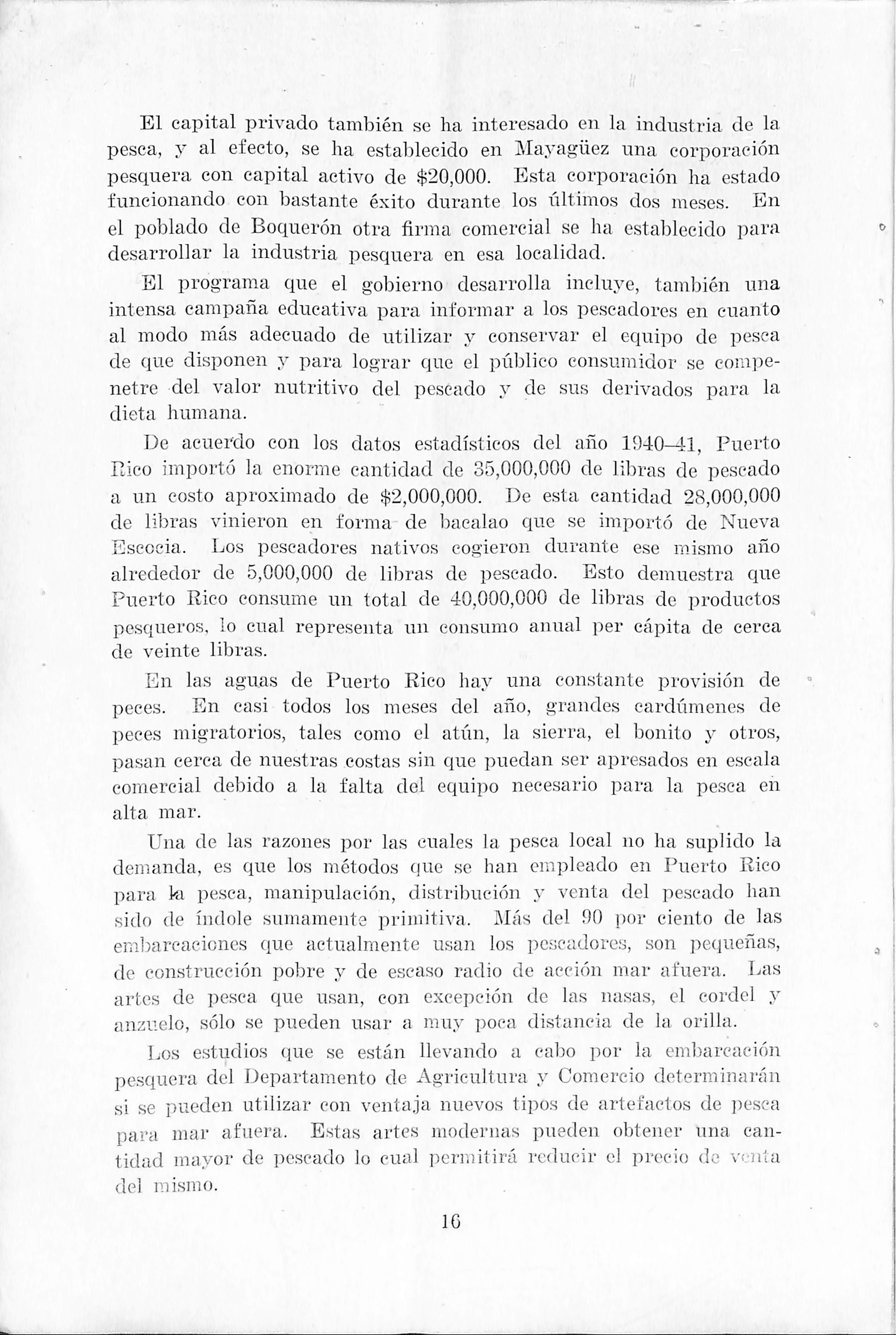
El capital privado también se ha interesado en la industria de la pesca, y al efecto, se ha establecido en Mayagüez una corporación pesquera con capital activo de $20,000. Esta corporación ha estado funcionando con bastante éxito durante los últimos dos meses. En el poblado de Boquerón otra firma comercial se ha establecido para desarrollar la industria pesquera en esa localidad.
El programa que el gobierno desarrolla incluye, también una intensa campaña educativa pax'a informar a los pescadores en cuanto al modo más adecuado de utilizar y conservar el equipo de pesca de que disponen y para lograr que el público consumidor se compe netre del valor nutritivo del pescado y de sus derivados para la dieta humana.
De acuerdo con los datos estadísticos del año 1940—11, Puerto Eico importó la enorme cantidad de 35,000,000 de libras de pescado a un costo aproximado de $2,000,000. De esta cantidad 28,000,000 de libras vinieron en forma de bacalao que se importó de Nueva Escocia. Los pescadores nativos cogieron durante ese mismo año alrededor de 5,000,000 de libras de pescado. Esto demuestra que Puerto Rico consume un total de 40,000,000 de libras de productos pesqueros, lo cual reiDresenta un consumo anual per cápita de cerca de veinte libras.
En las aguas de Puerto Rico hay una constante provisión de peces. En casi todos los meses del año, grandes cardúmenes de peces migratorios, tales como el atún, la sierra, el bonito y otros, pasan cerca de nuestras costas sin que puedan ser apresados en e.scala comercial debido a la falta del equipo necesario para la pesca en alta mar.
Una de las razones por las cuales la pesca local no ha suplido la demanda, es que los métodos que se han empleado en Puerto Rico para ki pesca, manipulación, distribución y venta del pescado han sido de índole sumamente primitiva. Más del 90 por ciento de las emlxareaeiones que actualmente usan los pescadores, son pequeñas, de construcción pobre y de escaso radio de acción mar afuera. Las artes de pesca que usan, con excepción de las nasas, el cordel y anzuelo, sólo se pueden usar a muy poca distancia de la orilla.
Los estudios tpie se están llevando a cabo por la embarcación pesquera del Departamento de Agricultura y Comercio determinarán si se pueden utilizar con venta.ja nuevos tipos de artefactos de pesca para mar afuera. Estas artes modernas pueden obtener una can tidad mayor de ixescado lo cual permitirá reducir el precio de venía del mismo.

Es obvio que con el establecimiento de un sistema de distribución que tenga por base la refrigeración y la transportación rápida; con la agrupación de pescadores en cooperativas debidamente organi zadas; con la adquisición de mayor número de embarcaciones del tipo actual que usan nuestros pescadores y adquisición de embarca ciones modernas para la pesca mar afuera, y con la ayuda de una campaña intensa que eduque a nuestro pueblo para que consuma más pescado fresco, no hay duda de que la pesca comercial en Puerto Rico podría desarrollarse y convertirse en una de nuestras princi pales industrias.

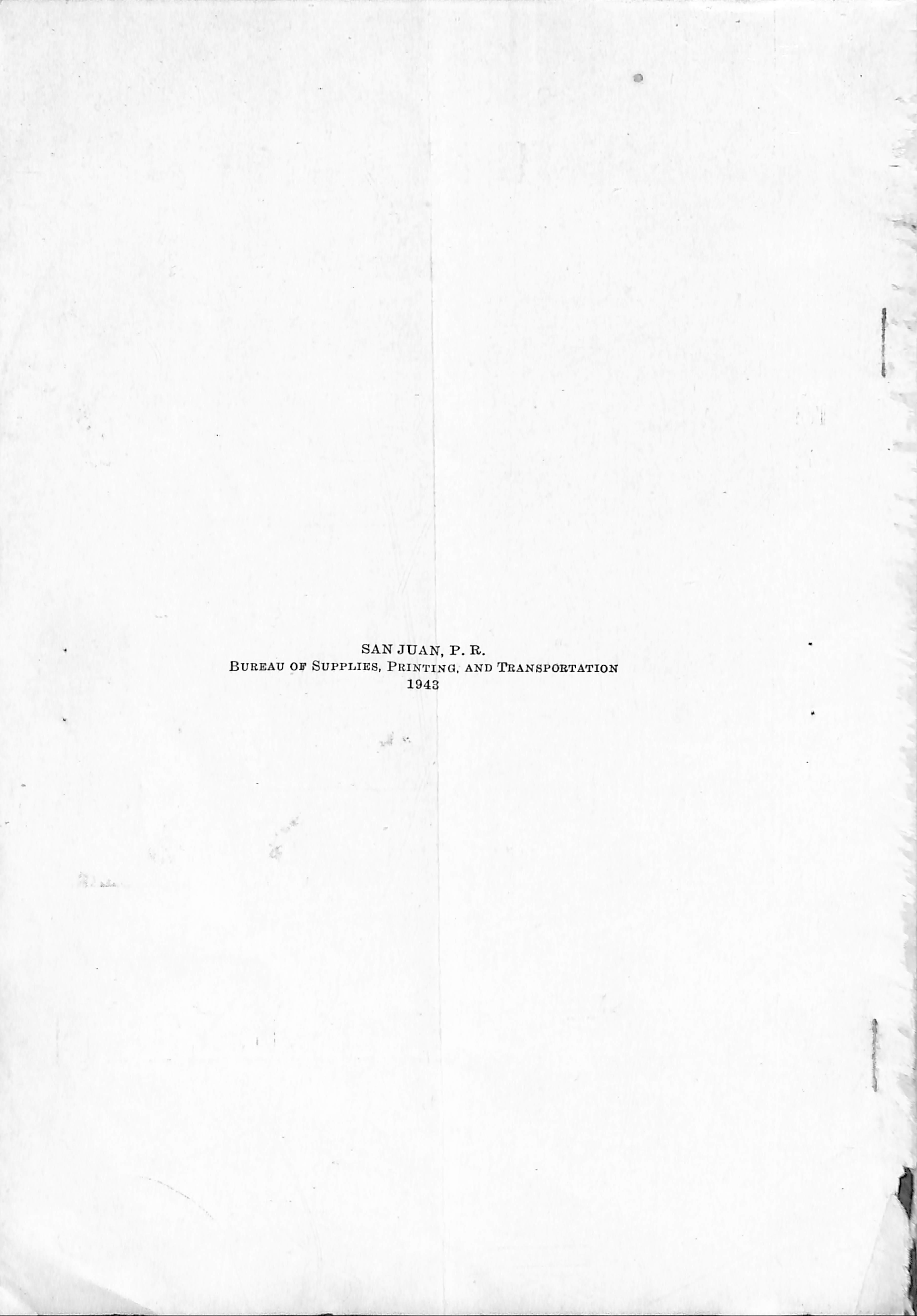
SAN JUAN,P.R.
Bueeau oe Supplies, Printino, and Thanspoetation 1943
. p ^ I M FISHERY BULLETIN
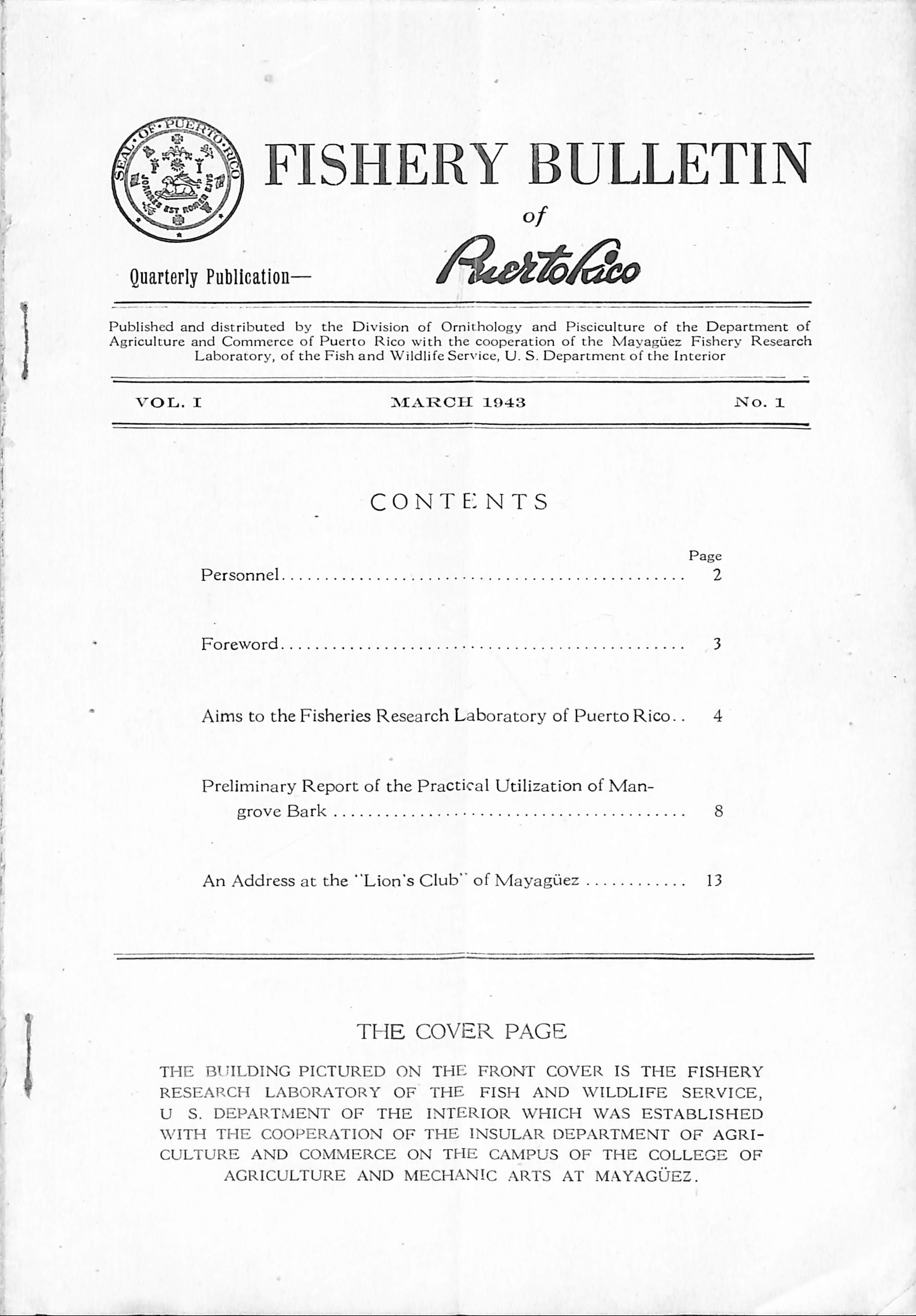
Quarterly Publlcation-
Publíshed and distributed by the División of Ornithology and Pisciculturc of the Department of Agriculture and Commerce of Puerto Rico with the cooperation of the Mayagüez Fishery Research Laboratory, of the Fish and Wildlife Service, U. S. Department of the Interior
MARCH 1943
CONTE: NTS
Personnel.
Foreword.
Aims to the Fisheries Research Laboratory of Puerto Rico.. 4
Preliminary Report of the Practical Utilization of Mangrove Bark 8
An Address at the "Lion's Club"" of Mayagüez 13
THE COVER PAGE
THE BUILDING PICTURED ON THE FRONT COVER IS THE FISHERY RESEARCH LABORATORY OF THE FISH AND WILDLIFE SERVICE, U S. DEPARTMENT OF THE INTERIOR WHICH WAS ESTABLISHED WITH THE COOPERATION OF THE INSULAR DEPARTMENT OF AGRI CULTURE AND COMMERCE ON THE CAMPUS OF THE COLLEGE OF AGRICULTURE AND MECHANIC ARTS AT MAYAGÜEZ.
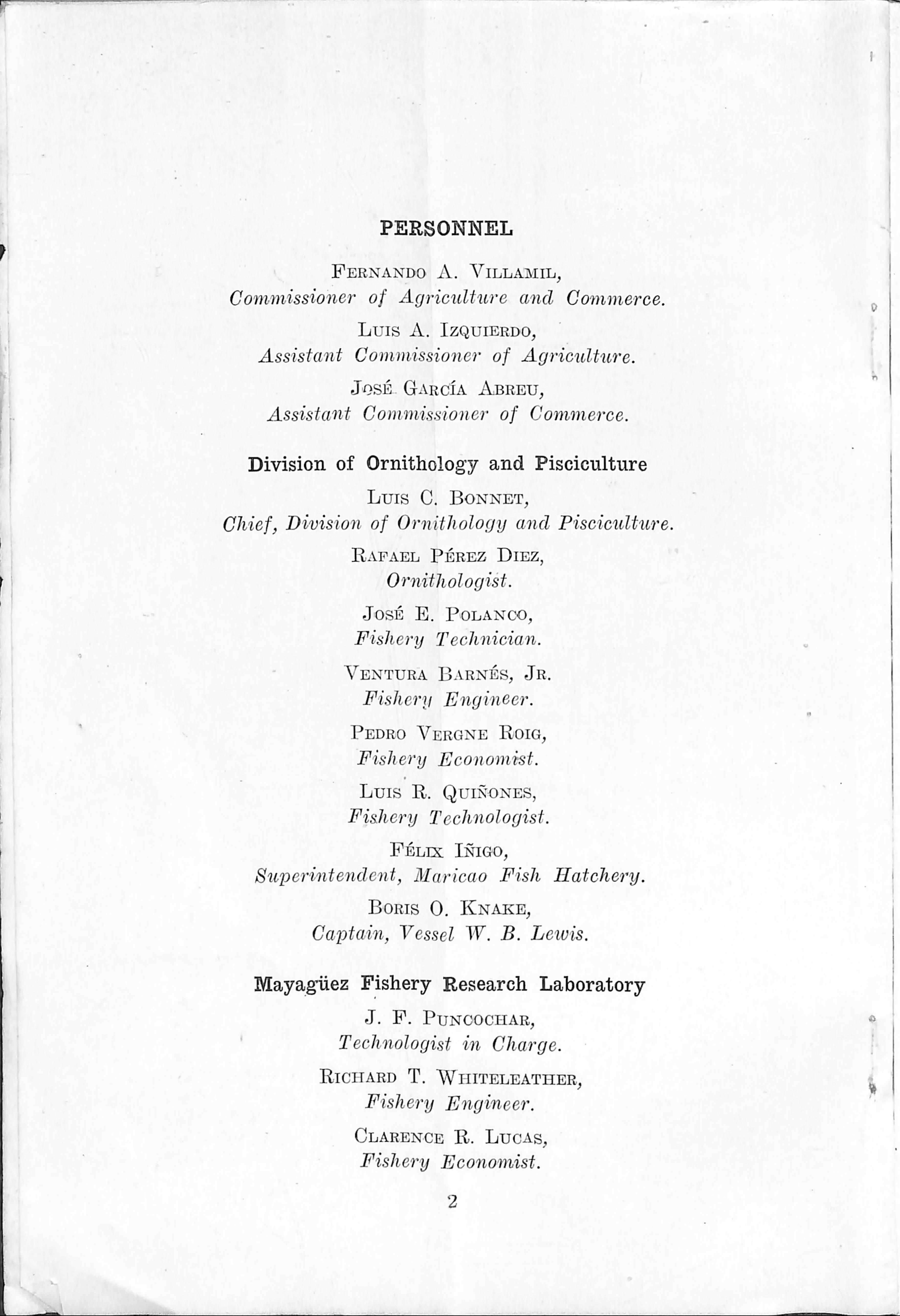
PERSONNEL
Fernando A. Villamil, Commissioner of Agriculture and Commerce.
Luis A. Izquierdo, Assistant Commissioner of Agricidture.
José García Abreu, Assistant Commissioner of Commerce.
División of Ornithology and Pisciculture
Luis G. Bonnet, Chief, División of Ornithology and Pisciculture.
Rafael Pérez Diez, Ornithologist.
José E. Polanco, Fisliery Technician.
Ventura Barnés, Jr. Fishery Engineer.
Pedro Vergne Roig, Fishery Economist.
Luis R. Quiñones, Fishery Technologist.
Félix Iñigo, Superintendent, Maricao Fish Hatchery.
Boris o. Knake, Captain, Vessel W. B. Lewis.
Mayagüez
Fishery Research Laboratory
J. F. PUNOOCHAR, Technologist in Charge. Richard T. Whiteleather, Fishej-y Engineer.
Glarence R. Lucas, Fishery Economist.

FOREWORD
Tliis is tlie first issue of the Fisliery Bulletin of Puerto Rico. The purpose of tliis publieation is to oífer information to tlie public concerniug the exiDeriments, stuclies and iDlaus that are being conducted in Puerto Rico for the promotion of the fishing iiidustry and to investígate the different problems confronted by said industry. Tliis program is being worked out by a cooperative agreeinent between the IMayagüez Pishery Research Laboratory of the IT. S. Fish and lYildlife Service, U. S. Department of the Interior and the División of Ornithology and Pisciculture of the Department of Agriculture and Commeree of Puerto Rico.
It is the intention of the Government to inaintain an ofticial publi eation for the purpose of oífering periodical information about the progress of the work and about the eíforts made toward the promotion of the fishing industry in the island.
This bulletin vill be sent free of charge to the fishermen of Puerto Rico, school teachers, civic clubs and organizations, fishery research centers of the Uiiited States and Latin América, universities and librarles of this Hemisphere-and to all persons that might apply for it.
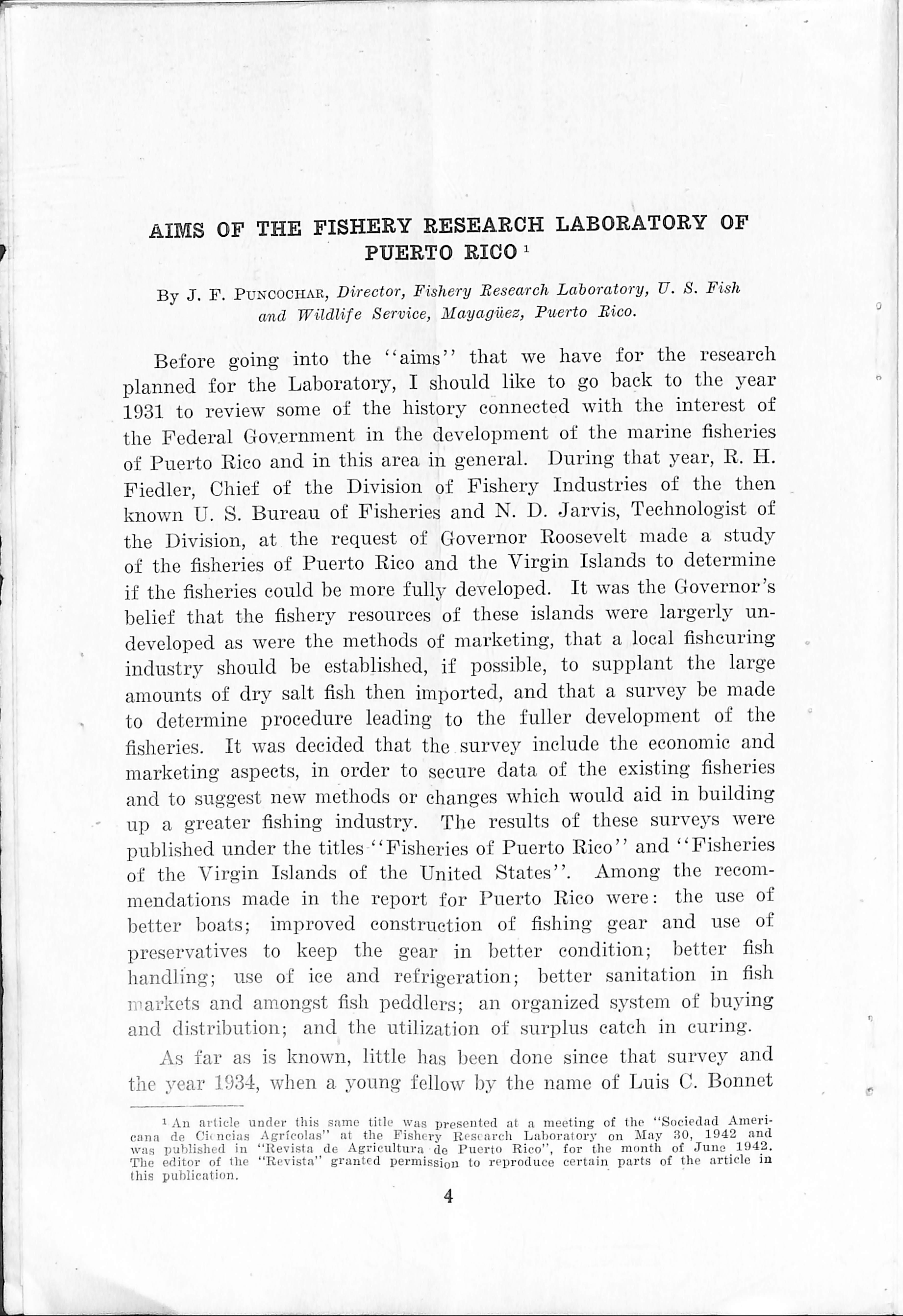
AIMS OF THE FISHERY RESEARCH LABORATORY OF PUERTO RICQi
By J. F, PuNCOCHARj Director, Fishery Mesearch Lahoratory, U. S. Fish and Wüdlife Service, Mayagiiez, Fuerto Mico.
Before going into the "ainis" that we have for the researeh planned for the Lahoratory, I should like to go back to the year 1931 to review some of the history connected with the interest of the Federal Gov.ernment in the development of the marine fisheries of Puerto Rico and in this area in general. During that year, R. H. Fiedler, Chief of the División of Fishery Industries of the then known U. S. Bureau of Fisheries and N. D. Jarvis, Technologist of the División, at the request of Governor Roosevelt made a study of the fisheries of Puerto Rico and the Virgin Islands to determine if the fisheries could be more fully developed. It was the Governor's belief that the fishery resources of these islands were largerly undeveloped as were the methods of marketing, that a local fishcuring industry should be established, if possible, to supplant the large amounts of dry salt fish then imported, and that a survey be made to determine procedure leading to the fuller development of the fisheries. It was decided that the survey include the economic and marketing aspects, in order to secure data of the existing fisheries and to suggest new methods or changos which would aid in building up a greater fishing industry. The results of these survej^s were published under the titles "Fisheries of Puerto Rico" and "Fisheries of the Virgin Islands of the United States". Among the recommendations made in the report for Puerto Rico were: the use of better boats; improved construction of fishing gear and use of preservativos to keep the gear in better condition; better fish handlíng; use of ice and refrigeration; better sanitation in fish markets and amongst fish peddlers; an organizad system of bujdng and distribution; and the utilization of surplus catch in curing.
As far as is known, little has been done since that survey and the 3'ear 1934, when a young fellow by the ñame of Luis C. Bonnet
^ An article under this same title was preseiiled at a meeting of the "Sociedad Ameri cana de Ci. ncius Agrícolas" at the Fishery Rcsiarch Lahoratory ou May 30, 1942 and ivas iiublished in "Revista de Agricultura de Puerto Rico", for the month of June 1942. The editor of the "Revista" granted permissiou to reproduce certain parts of the article la this publication.

caine into the picture." His interest at that time was primarily. in doing something for the development of the fresh-water fisheries.
Realizing that the various rivers and streams of the Island would provide a nourishing food for the low-ineome groups of people, this young man through interest stimulated by Mr. Rafael Menéndez Ramos, Deán of the College of Agrieulture of the University of Puerto Rico and Dr. Hildebrand of the United States Pish and Wildlife Sex'vice, set about stocking the rivers and streams with certain species of fish brought from the United States, that could adapt themselves to the conditions in Puerto Rico. To aid in the fine work, there was established at Marieao, one of the most modern fish hateheries in this hemisphere.
Later, in the year 1939, Mr. Fiedler, Chief of the División of Fishery Industries of the presently known U. S. Fish and Wildlife Service, was detailed to serve as a technical advisor of the President s Edueational Commission whieh was sent to Puerto Rico to study the facilities of the University of Puerto Rico and to determine whether this institution might be made into an Inter-Ameriean University. One of the recommendations made by this commission was to establish a Fishery Researeh Laboratory in the Island, the purpose of which would "be to further the development of the fisheries here as well as in other Latin-American Republics. Glose cooperation was indieated with the University of Puerto Rico and other Insular agencies to accomplish this.
As a result of this work and efforts on the part of the Federal and Insular Governments, interest in the fisheries was stimulated and funds were obtained to build, equip a fishery researeh laboratory, and to start a program for investigating the fishery resources of the waters of Puerto Rico and the Virgin Islands in particular, and the West Indies in general.
The "aims" of the Fishery Researeh Laboratory are covered in a joint agreement between the Fish and M ildlife Service of the United States Department of the Interior and the Department of Agrieulture and Commerce of Puerto Rico. The nature and extent of" the program was determined by the Service after consultation with the Commissioner of Agrieulture and Commerce and the Fisheries Consulting Board of Puerto Rico as authorized under Act 157 passed by the Legislature of Puerto Rico on May 13, 19-41. The programs calis for (1) Evaluation of present nature, extent, and magnitude of the fishery industries of Puerto Rico, (2) Study of supply and distribution of marine food fishes off the coast of Puerto Rico and adjacent waters, (3) Technology of fish preservation and

development of preserved fishery products, and (4) Economic relationships pertaining to fish capture, preservation and marketing. Mucli of the information under the first heading has already been obtained. We are at pre.sent engaged in exploratory survey work which will supply us with information relativo to the use of fishing gear now in suecessful operation in the United States. We are trying this gear for eapturing fish to be found in Puerto Rico and adjacent waters. Explorations of inshore, offshore, and bottom location will be made. Efforts will be made to determine the most efficient methods for máximum production without endangering the future of the fishery.
The Amrious types of speeies eaught will be identified and data obtained on their seasonal and spatial distribution. Specimens of fish will be taken for study at a latter date of the racial and speeies characteristics and for' studies of life history phenomenas. Also factors influeneing abundanee and distribution will be investigated. The effeet of current conditions on the movements of fish, the dis tribution and the abundanee of foocl organisms, water temperature observations, and salinity determinations will also be considered in connection with the exploratory work.
The technological phases of the program will involve studies on the preservation of the cateh aboard the fishing vessel and will include the proper methods to be used in ieing, dressing, and bleeding of the fish. Proper preservation of fishery products at ports of landing will also be investigated. A study will be made in this connection on the best type of eontainers to be used for the icing of fresh fish for shipment. Consideration will be given to the use of low temperature cabinets for storage of fishery products in retail stores. Experimentation on the preparation of salted fish principally by the dry-salt methods and preparation of packs of smoked fish will be carried out. Canned fishery j)roducts including canned fresh, smoked, and dried fish will be prepared by various methods tó determine the best procedure to be used for the fish eaught in Puerto Riean waters. Some time will also be devoted to the preparation of by-products. Studies dealing with the chemical preservation of fish livers, aeidulation of fish and shellfish scrap for use as fertilizers, and the drying of fish scrap for use as a source of minerals and protein for the diet of farm animals will be made.
The economic studies will include the following: extent of transportation faeilities including railroads and highways, faeilities for marketing fish through retail stores, wage levels of various groups of the population and their ability to buy fish, food habits of the

people, location of fishing ports with respect to centers of population, feasibility of relocating ports, and existing facilities of preserving fishery products.
Froni the brief remarks made of tlio aims of the Fishcx'y Research Laboratory, it can readily be seen that our job is by no ineans an easy one. No predietions can be made as to the length of time that will be consumed in carrying out our program. War has imposed certain ineonveniences which may adverselr^ affect the progiam. In the short period that we have been in Puerto Rico some of our efforts are beginning to bear fruit. Since the establishment of the Laboratory, we have noted that suggestions made by us are being put into actual practico by firms newly engaged in the fishing industry. Reeommendations made to these firms in handling and refrigerating fish on vessels, at points of landing, and dui'ing tiansit to market are at present in effect.
Through cooperation with other Federal and Insular agencies we are assisting in the establishment of fishing cooperatives in-several places in the Island. Loans have been made to these cooperativos to purchase fishing vessels, fishing gear, and for improving, shore facilities. Plans are also under way to furnish land to fishermen so that living eonditions in fishing centers might be improved.
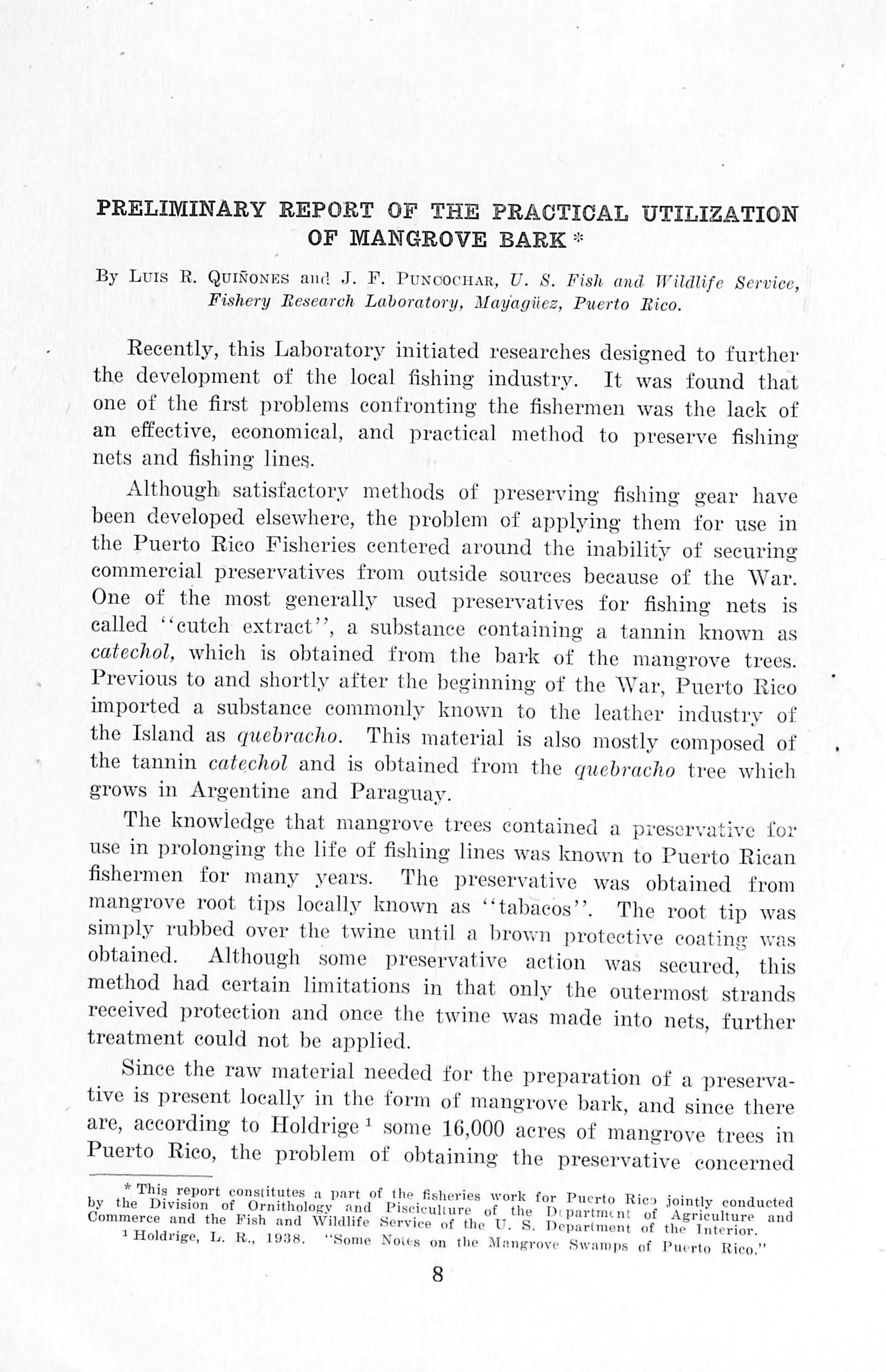
PRELIMINARY REPORT OF THE PRACTICAL UTILIZATION OF MANGROVE BARK *
By Luis R. Quiñonks aiul J. F. Punoociiar, V. S. Fish and WildUfc Scrvice, Fishery Eesearch Lahoratory, Mayagiiez, Puerto Eico.
Reeently, this Laboratorj' initiated researches designed to further the development of the local fishing industry. It was found that ene of the first problems confronting the fishermen was the laek of an effeetive, ecoiioniicah and practical method to preserve fishing nets and fishing lines.
Although satisfactory methods of preserving fishing gear have been developed elsewhere, the problem of applying them for use in the Puerto Rico Pisheries centered around the inability of securing eommercial preservatives from outside sourees because of the War. One of the most generally used preservatives for fishing nets is called cutch extract , a substance containing a tannin known as catechol, which is obtained froin the bark of the mangrove trees. Previous to and shortly after the beginning of the War, Puerto Rico imported a substance eommonly known to the leather industry of the Island as quebracho. This material is also mostly composed of the tannin catechol and is obtained froin the quebracho ti'ee which grows in Argentine and Paraguay.
The knowledge that mangrove trees contained a preservativo for use in prolonging the life of fishing lines was Imown to Puerto Rican fishermen for many years. The preservativo was obtained from mangrove root tips locally known as "tabacos". The root tip was simply rubbed over the twine until a brown protoctive coating was obtained. Although some preservativo action was secured,^ this method liad certain limitations in that only the outermost sü'ands received proteetion and once the twine was made into nets, further treatment could not be applied.
Since the raw material needed for the preparation of a preserva tivo is present locally in the form of mangrove bark, and since there are, aecording to Holdrige ^ some 16,000 acres of mangrove trees in Puerto Rico, the problem of obtaining the preservativo concerned
Commerce and the Fieh and Wiidlife Serviee of th„"u. s ímern of HoT ^Holdr.ge, L. R., 1U38. ■'Hon.e Noue on tho MaoRrov,- ,Stvan,p.s „t Rieo"

itself witli the development of an econoniieal method of extraction, with the ultimate use of the extraet for the "barking" of fishing fines and nets and possibly the tanning of hides by already aecepted methods.
The mangrove assoeiation of the Island eonsists principally of tlie four speeies that follow:
1. Rhizophora mangle i.—loeally knoM'n as "mangle colorado" or ''zai^atero'
2. Conocarpus erecta L.—locally known as "mangle botón" or "botoncillo".
3. Laguncularia racemosa L. Gaertn.—locally known as "man gle blanco" or "bobo".
4. Avice^inia niticla Jacq.—locally known as "mangle negro".
The specics Rhizophora or "red mangrove" is most commonly used as a souree of tannins, consequently the bark of this speeies was considered first in the extraction experiment described latcr. This speeies eonstitutes about 20 per cent of the mangrove ¡Dopulation of Puerto Rico and commonly grows in or near to tidal waters. Inasmuch as all speeies of mangrove trees are used extensively in the production of charcoal, the bark might possibly be obtained as a bj-pioduct, thus adding to the valué of the charcoal industry.
Method of Extr.vction
The leaching principie of extraction was utilized. The apparatus (Pig. 1.) was construeted at the Laboratory and consistcd of three water tight barréis of approximately 75 gallons capacity each. These weie airanged in a battery so that the barréis would discharge by gravity. Each barrel was equipped with a perforated copper steam coil, a hot water service, and a brass valve for discharging the liquids. The lowest barrel was equipped with a rotary moncl metal pump to circuíate the extraet to the highest barrel in the battery.
In starting the cycle for extraction, each barrel was charged with 80 pounds of freshly eut bark. The pieees of bark ranged from 1 inch to 3 inches in size. The uppermost barrel was filled with warm water up to % of its height. The initial temperature of the water was 180 degrees Fahrenheit. This was raised as rapidly as possible to approximately 208 degrees F. with steam and was maintained for a period of three hours. Samples of the extraet were taken at hourly intervals for the determination of total soluble solids. After the three hour extraction period, the tan liquor was passed mto the second barrel. Hot water was again added to the uppermost barrel and simultaneous extraction was earried out in both barréis

FIG. 1.—Apparatus used for the extraction of mangrove bark. Lids are placed on barréis when extractor Is operatlng. Barréis in foreground are for the storage of the extract.

The eni'iched tan liquor from the seeond barrel was passed into tlie lowermost barrel and the weak tan liquor resulting from the second hot water extraction in the uppermost barrel was passed into the second barrel. The bark fi-om the uppermost barrel at this point was disearded. Simultaneóos exti'aetion was again earried out in the second and lowermost barréis. The extract from the lowermost barrel was withdrawn and constituted the final sample. Por eontinuing the eyele, the tan liquor from the second barrel was passed into the lower barrel, extracted, and pumped again into the upper most barrel and at the same time a third extraction with hot water was made in the second barrel after which the bark was disearded and replaced by fresh bark. The resulting eycle enabled each charge of bark to undergo three extractions, thus enriehing the liquor each time and assuring fairly complete extraction of the bark. A concentrated tan liquor when the cycle is complete is available every three' hours.
Results
Each final extraction yielded about 40 gallons of tan liquor of about 10 per cent solids in solution of which the greater part are believed to be tannins of the catechol group. A preliminary extrac tion using finely ground bark indicated that a higher yield of tannins could be obtained and time of extraction considerably shortened. However, difficulties in the separation of the tan liquor from the finely ground bark did not warrant further triáis.
Preliminary tests with the extract for the treatment of fishing lines and nets indicated that it can satisfactorily be applied as a preservativo.
The extract was also tried in the treatment of skins at a tannery located near the City of Mayagüez. Reports from the operator indicated that skins treated compared favorably with skins formei'ly treated with quebracho extract.
Discussion
From the preliminary work eondueted thus far, it appears that extracts prepared from "red mangrove" bark by the method described are satisfactory for the preservation of fishing gear and the tanning of hides. The quality of the extract could possibly be improved by further experimentation on the temperatures of extraction. Additional work along this line is planned for the near future. It is belie\ ed that the oxidation of tannins could be substantially

diminished through the use of lower temperatures. The effeet of teiiiperature on tlie yield and color of the extract will also be detennined in later experiments.
Although additional experimentation is planned, it is believed that the information reported is suffieient to warrant the use of the exti'action method described in preparing an extract for use in the fishing and leather industries of the Island. Tannery operators report that there is a shortage of leather because they cannot iinport quebracho. As a result of this condition many tanneries were torced to cióse. Larger unit extraction plants of the type described could possibly be constructed in each tannery to supply extract for current requiremcnts or pos.sibly a central extraction plant could be established to supply the requirements of all the tanneries. This central plant could also supply the extract to fisheriuen for preserving fishing gear.
On the basis of figures supplied by the owners of tanneries, the cost of quebracho at the present time is $11 per quintal. Annual requirements for this substance are approximately 7,000 quintáis, valued at $77,000. Estimates of the cost of producing a comparable amount of mangrove extract after the initial cost of constructing the extraction plant would save the leather industry at least $30,000 annually. In addition, more people would be employed and the in dustry would be able to opérate the year round through the use of a locally produced product.
The authors wish to express their gratitude to Mr. Marcial R. Díaz, Head of the Department of Chemical Engineering, College of Agriculture and Mechanic Arts, Mayagüez, Puerto Rico for furnishing certain materials for use in the construction of the extraction apparatus.
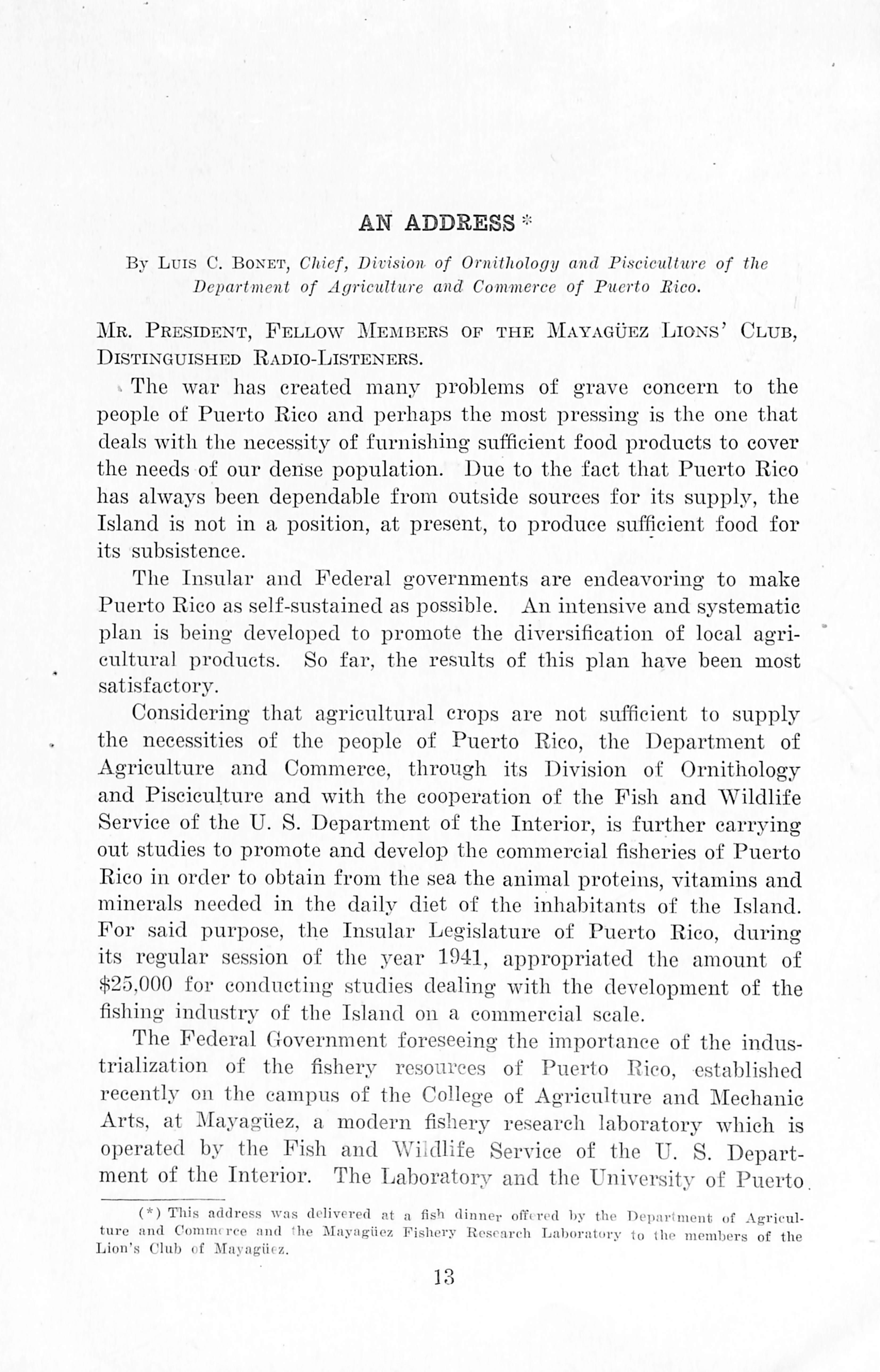
AN ADDRESS -
By Luis C. Bonet, Cliief, División of Orniiliology and Fisciculhirc of tlie Dcpartment of Agriculiure and Commerce of Puerto Mico.
Mr. President, Pellow Members of the Mayagüez Lions' Club, Distinguished Radio-Listeners.
■ The war lias created mauy pi'obleins of grave concern to the people of Puerto Rico and perhaps the most pressing Is the one that deals with the necessity of furnishing sufficient food products to cover the needs of our dense population. Due to the fact that Puerto Rico has always been dependable from outside sources for its supply, the Island is not in a position, at present, to produce sufficient food for its subsistence.
The Insular and Federal governments are endeavoring to make Puerto Rico as self-sustained as possible. An intensive and systematic plan is being developed to promote the diversification of local agri cultura! products. So far, the results of this plan have been most satisfactory.
Considering that agricultura! crops are not sufficient to supply the necessities of the people of Puerto Rico, the Department of Agriculture and Commerce, through its División of Ornithology and Pisciculture and with the cooperation of the Pish and Wildlife Service of the U. S. Department of the Interior, is further carrying out studies to promote and develop the commercial fisheries of Puerto Rico in order to obtain from the sea the animal proteins, vitamins and minerals needed in the daily diet of the inhabitants of tbe Island. Por said purpose, the Insular Legislature of Puerto Rico, duiúng its regular session of the year 1941, appropriated the amount of $25,000 for conducting studies dealing with the development of the fishing industry of the Island on a commercial scale.
The Federal Government foreseeing the importance of the industrialization of the fishery resources of Puerto Rico, e.stablished recently on the campus of the College of Agriculture and Mechanic Arts, at Mayagüez, a modern fishery research laboratory which is operated by the Pish and Wiidlife Service of the U. S. Depart ment of the Interior. The Laboratory and the University of Puerto,
(*) Tliis addre.ss w.ts cldivered .at a fls'i diniun- offi nal Ijy the Depavlinont <it .VkvícuIture and Commi rt-e .and the Mayagüez Fishery Research Lalxiratory tu the members of the Lion's Club of Mayagíitz.

Rico are offering every year, four scholarships of $540 each, to students of the College for working part-time on fishery projeets at the Laboratory. The purpose in offering these scholarships, is to prepare technieians in the fielcl of fisheries. The city of Mayagüez, should he proud in liaving this íahoratory since there are only four of its kind established in our hemisphere.
The laboratory has modern equipinent and is directed by J. F. Puncoehar, of the U. S. Fish and Wildlife Service. This project is being worked in cióse cooperation with the División of Ornitology and Piscicultnre of the Department of Agriculture and Commerce. The prograin developed by the aforeinentioned agencies, inclndes investigations of technological eharacter in relation to the improvement nf methods of handling fresh and frozen fish, salting, drying, smoking and the ntilization of the by-products of the industry.
In order to obtain advantage of this program, oeeanographic and biologieal studies of the waters around Puerto Rico are being condueted so as to determine the type of vessels and fishing gear best adapted to our conditions, species of fish that oífer better possibilities for the commercial fisheries, seasons when they are most abundant, studies of the nature of the bottom of the sea, localization of new fishing grounds and colleetion and classification of the fishes found in the waters of Puerto Rico. For this phase of the program, the Department of Agriculture and Commerce aequired by purehase a modern fishing vessel equipped with different types of fishing gear and manncd by an experienced erew. Up to date, the waters of the western coast, including the waters of Mona, Monito and Desecheo Islands, have been explored. Various trii^s to the fishing banks of the northern, eastern and southern coasts have also been made. Although the fishery activities are mainly of an exploratory nature, in many instances it has been found that various fishing banks are quite productive and that with the use of certain types of fishing gear these banks may offer possibilities to engage in fishing on a commercial seale. Attention is also being offered to the practieal aspects of the industry, such as organization of the fishermen by means of cooperativos, improvement of the handling, distribution and transportation methods and facilities of refrigeration and marketing. Sucess has been attained in the recent establishment of a fishermen cooperative at Junta Pozuelo, Guayama, Puerto Rico. Funds for this cooperative were obtained from the Farm Security Administration. The Cooperative was organized by the Redemptorist Fathers of Guayama, with the help of the División of Ornithology and Piscicultnre of the Department of Agriculture and
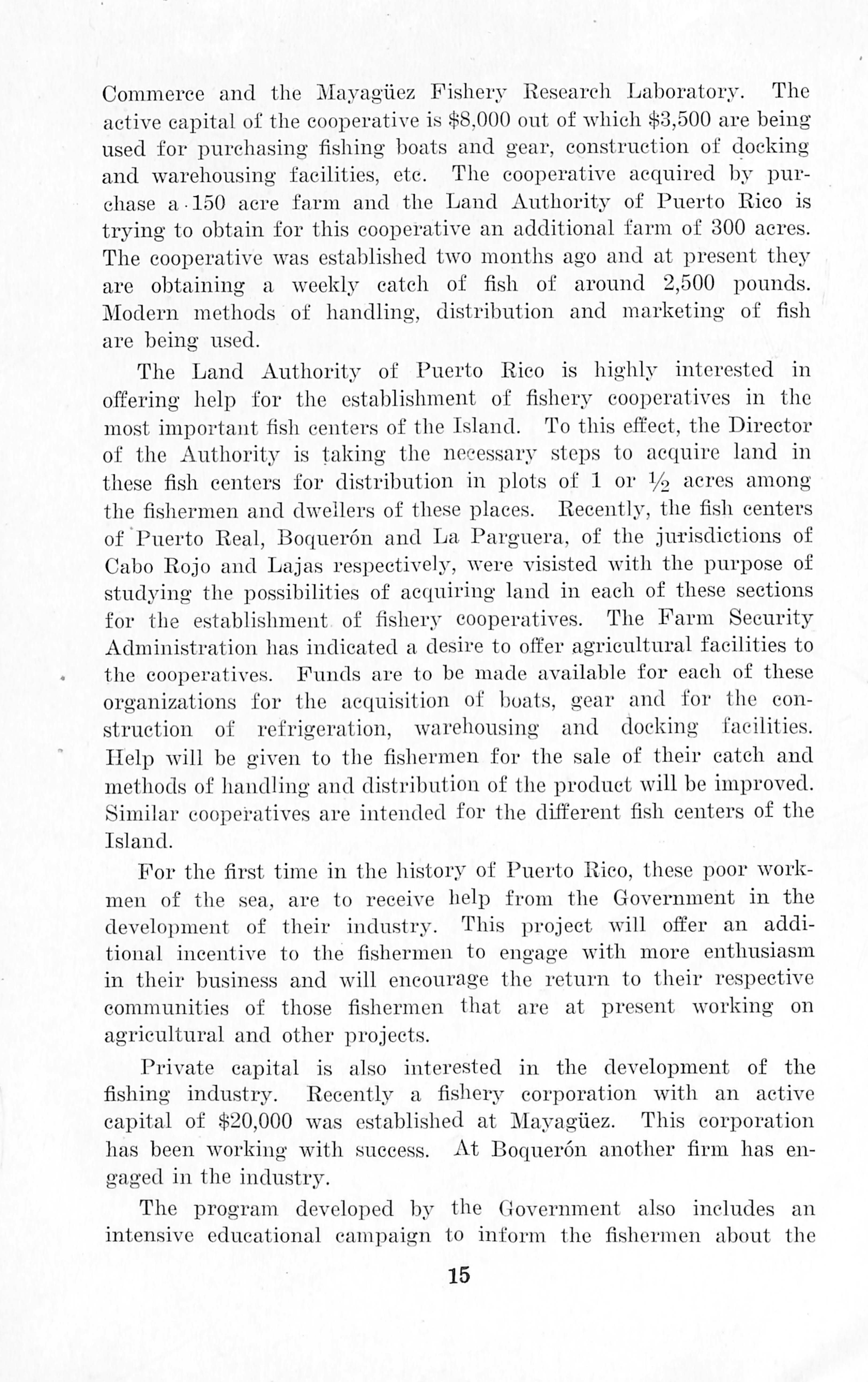
Commerce and the Mayagüez Pishery Research Laboratory. The active capital of the eooperative is $8,000 out of wliicli $3,500 are being used for purchasing fishing boats and gear, construction of docking and warehousing facilities, etc. The eooperative acquired by purchase a ■ 150 aere farin and the Land Anthority of Puerto Rico is trying to obtain for this eooperative an additional farm of 300 acres. The eooperative was established two nionths ago and at present they are obtaining a weekiy eatch of fish of around 2,500 pounds. Modern methods of handling, distribution and marketing of fish are being used.
The Land Anthority of Puerto Rico is highly interested in offering help for the establishment of fishery cooperatives in the inost important fish centers of the Island. To this eíí'eet, the Director of the Authority is taking the necessary steps to acquire land in these fish centers for distribution in plots of 1 or i/o acres ainong the fishermen and dwellers of these places. Recently, the fish centers of Puerto Real, Boquerón and La Parguera, of the jurisdictions of Cabo Rojo and Lajas respectively, were visisted Avith the purpose of studying the possibilities of aequiring land in each of these sections for the establishment of fishery cooperatives. The Farm Security Administration has indicated a desire to offer agricultural facilities to the cooperatives. Funds are to be inade available for each of these organizations for the acquisition of boats, gear and for the con struction of refrigeration, wareliousing and docking facilities. Help will be given to the fishermen for the sale of their eatch and methods of handling and distribution of the product will be improved. Similar cooi^efatives are intended for the diíferent fish centers of the Island.
For the first time in the history of Puerto Rico, these poor workmen of the sea, are to receive help from the Government in the development of their industry. This project will offer an addi tional incentive to the fishermen to engage with more enthusiasm in their business and will eneourage the return to their respective communities of those fishermen that are at present working on agricultural and other pi'ojects.
Prívate capital is also interested in the development of the fishing industry. Recentlj^ a fishery corporation with an active capital of $20,000 was established at Mayagüez. This corporation has been working with success. At Boquerón another firin has engaged in the industry.
The program developed by tire Goverrrmerrt also irrcludes arr intensive educational campaigir to irrform tire fishermeir about the
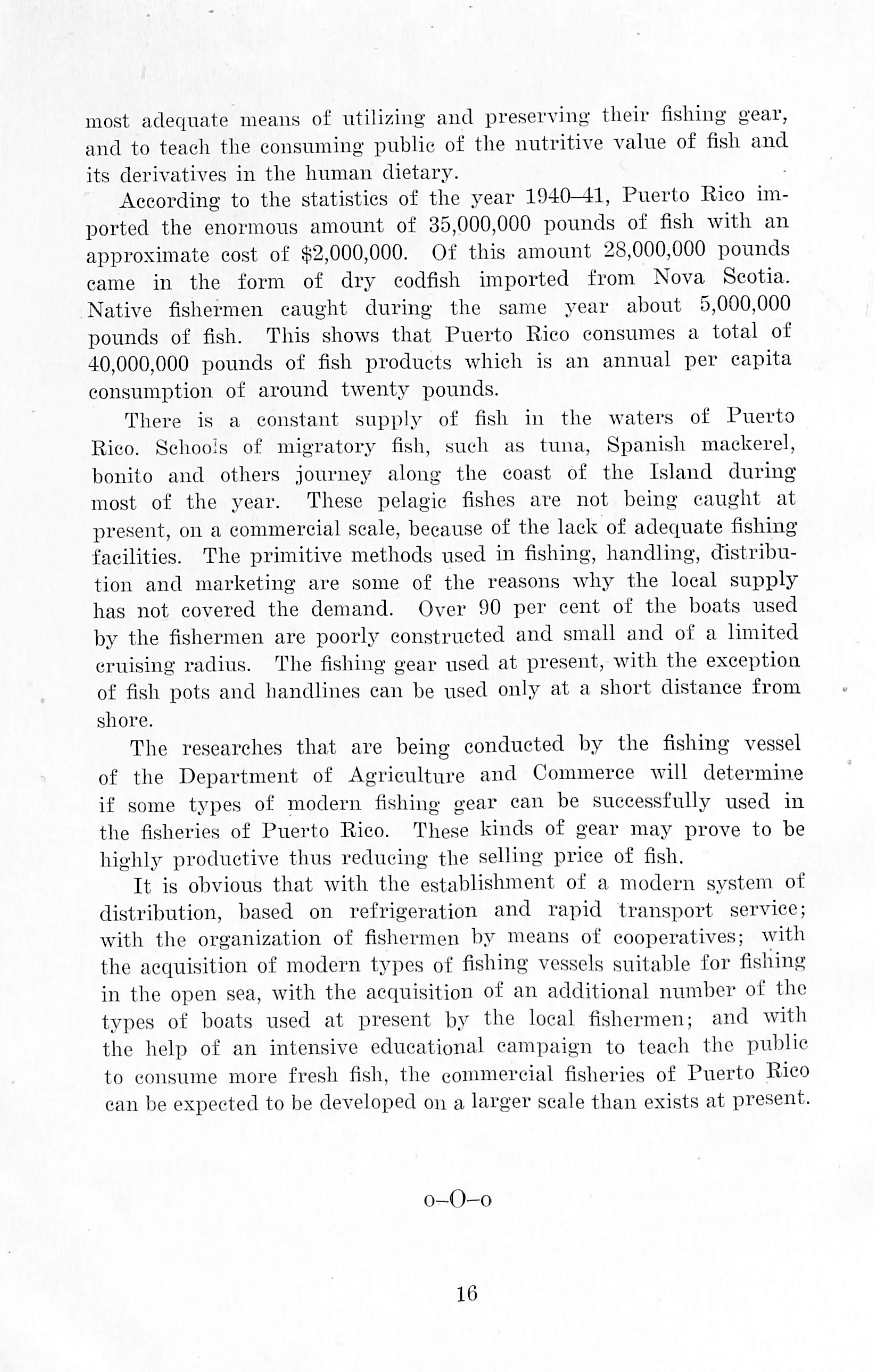
most adequate meaiis of iitilizing aud preserving tlieir fishing gear, and to teach tlie consumiiig public of tlie niitritive valué of fisli and its derivatives in tlie liviman dietary.
Aecording to the statistics of the yeax' 1940-41, Pxierto Rico imported the enoriuous amount of 35,000,000 pounds of fish with an approximate cost of $2,000,000. Of this amount 28,000,000 pounds came in the form of dry codfish imported from Nova Seotia. Native fishermen eaught during the same year about 5,000,000 pounds of fish. This shows that Puerto Rico consumes a total of 40,000,000 pounds of fish producís which is an animal per capita consumption of around twenty pounds.
There is a constant supply of fish iii the waters of Puerto Rico. Sehoois of migratory fish, such as tuna, Spanish mackerel, bonito and others jouriiey along the coast of the Island during most of the year. These pelagic fishes are not being eaught at present, on a commercial scale, because of the laek of adequate fishing facilities. The primitivo methods used in fishing, handling, distribution and marketing are some of the reasons why the local supply has not eovered the demand. Over 90 per cent of the boats used by the fishermen are poorlj'' constructed and small and of a limited cruising radius. The fishing gear used at present, with the exeeption of fish pots and handlines can be used only at a short distance from shore.
The researches that are being conducted by the fishing vessel of the Department of Agriculture and Commerce will determine if some types of modern fishing gear can be successfully used in the fisheries of Puerto Rico. These kinds of gear may prove to be highly produetive thus reducing the selling price of fish.
It is obvious that with the establishment of a modern system of distribution, based on refrigeration and rapid transport service; with the organization of fishermen by means of cooperativos; with the acquisition of modern types of fishing vessels suitable for fishing in the open sea, with the acquisition of an additional number of the types of boats used at present by the local fishermen; and with the help of an intensivo educational campaign to teach the public to consume more fresh fish, the commercial fisheries of Puerto Rico can be expected to be developed on a larger scale than exists at present.
